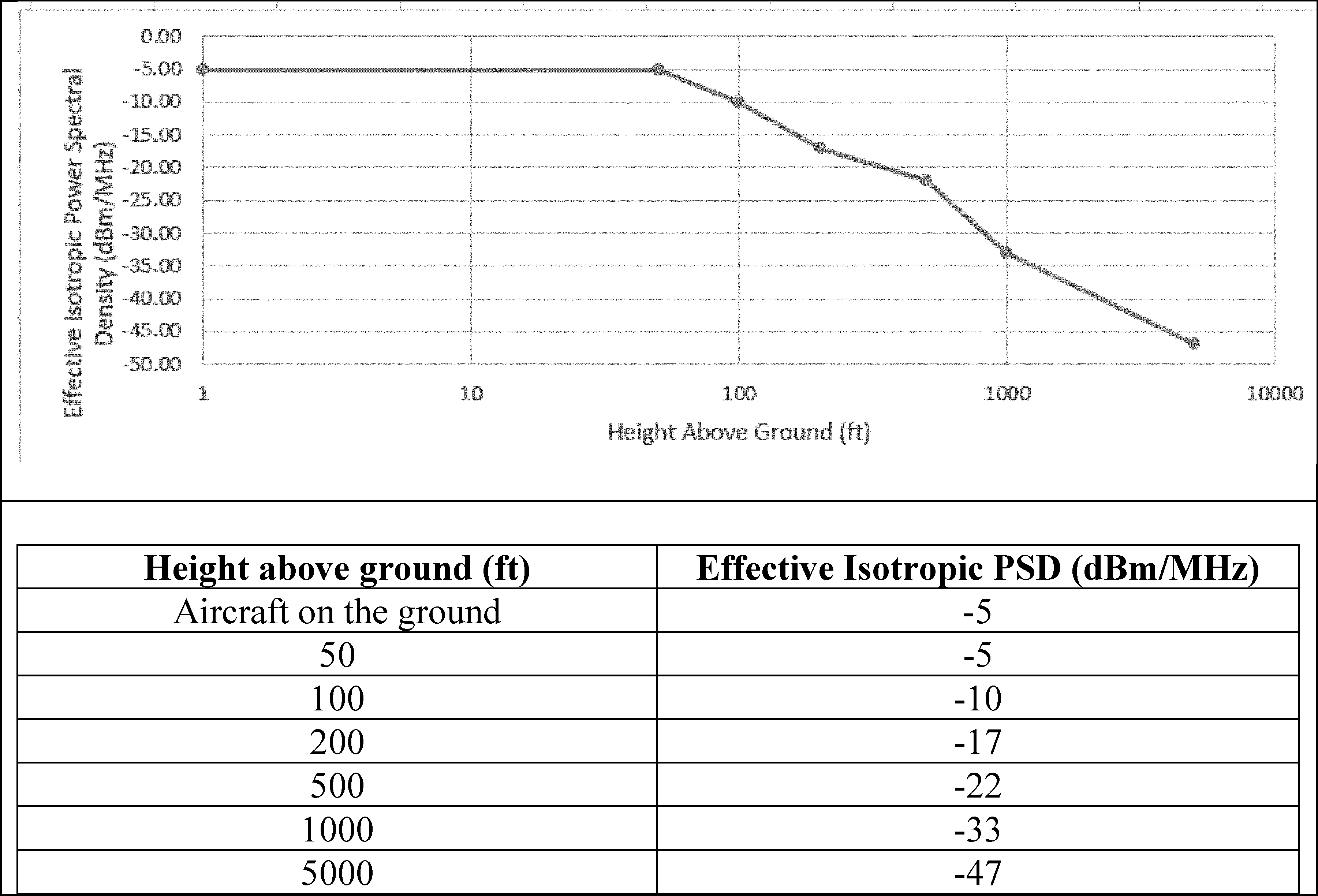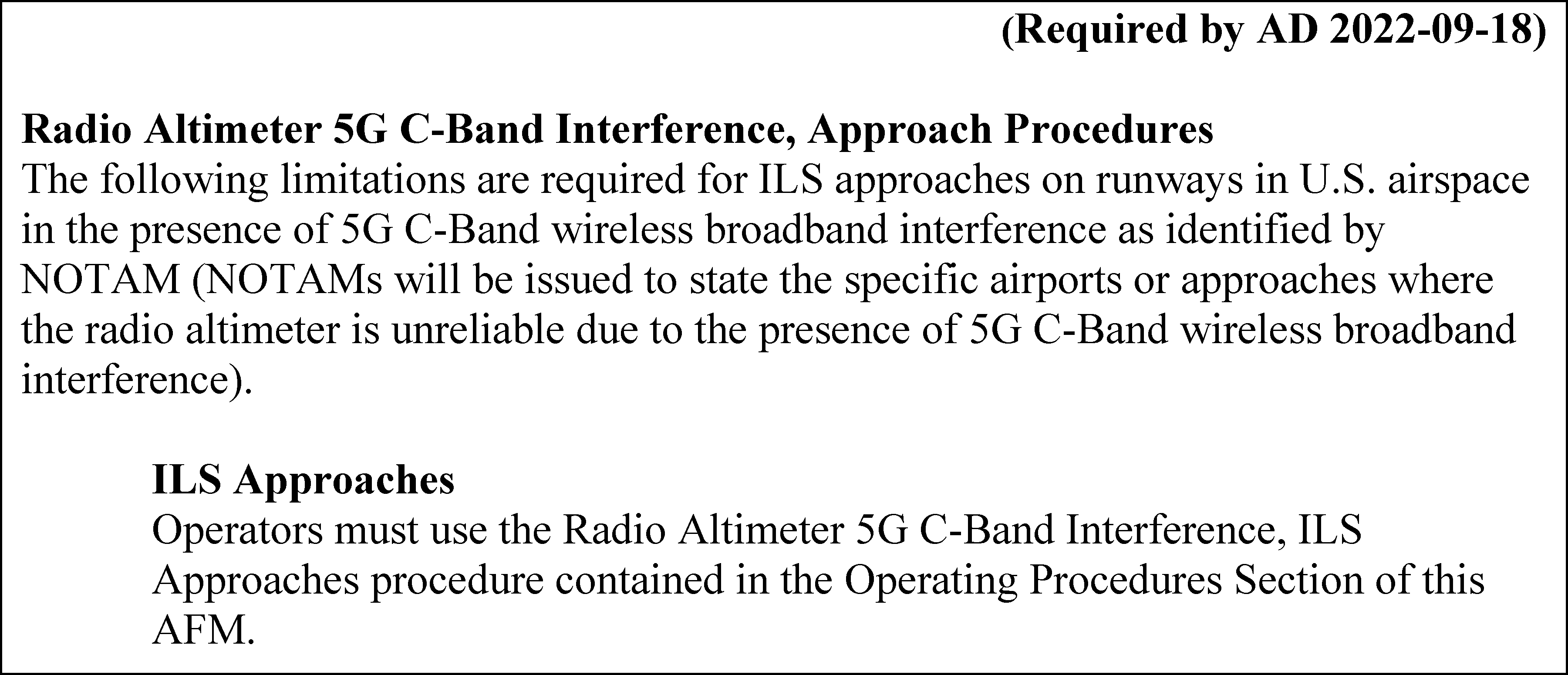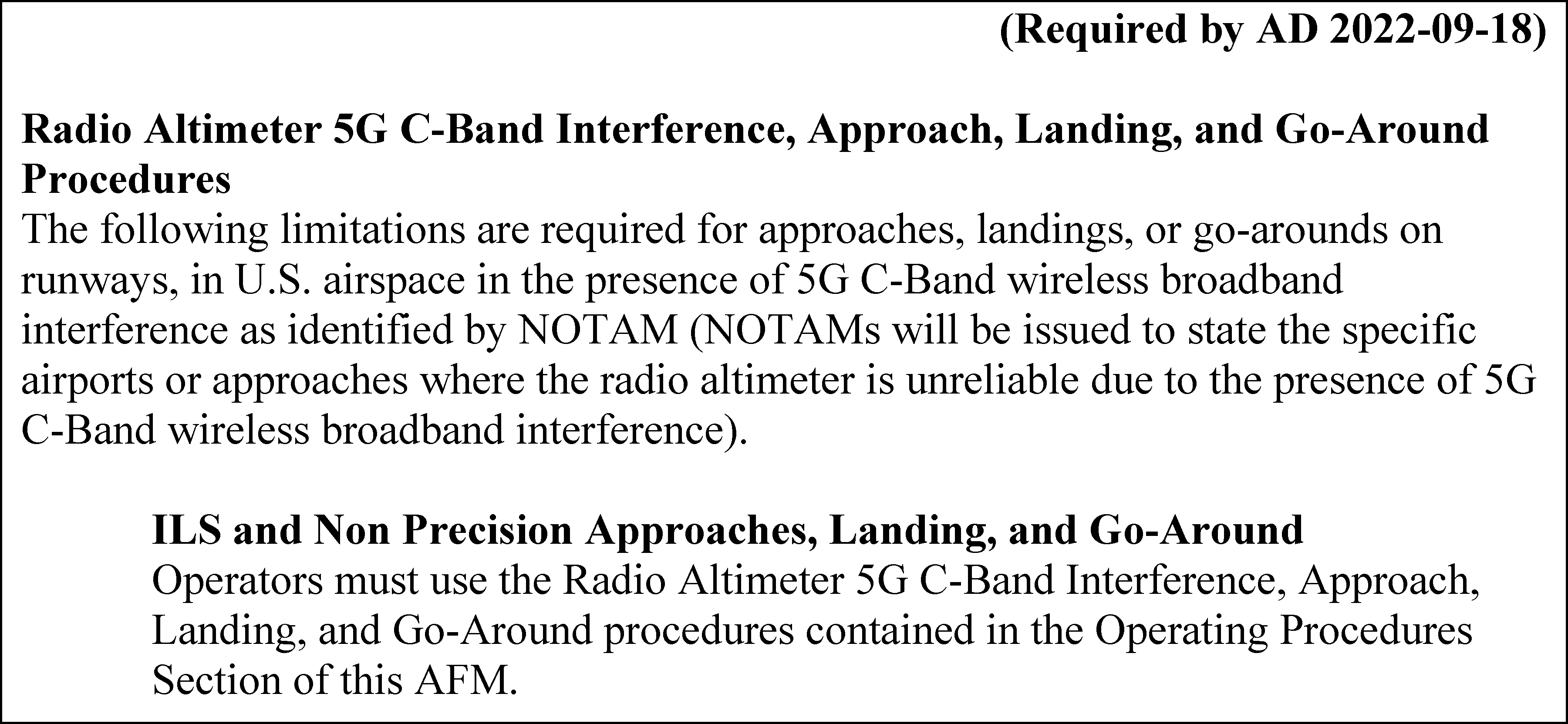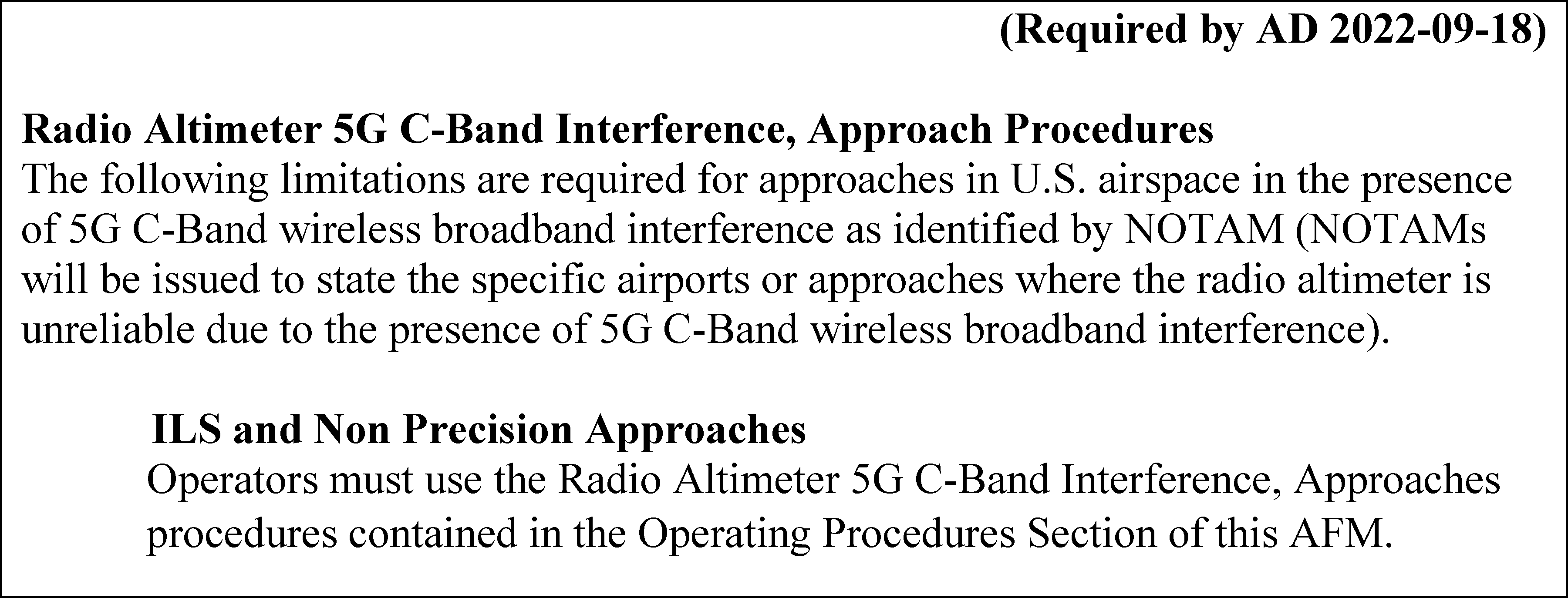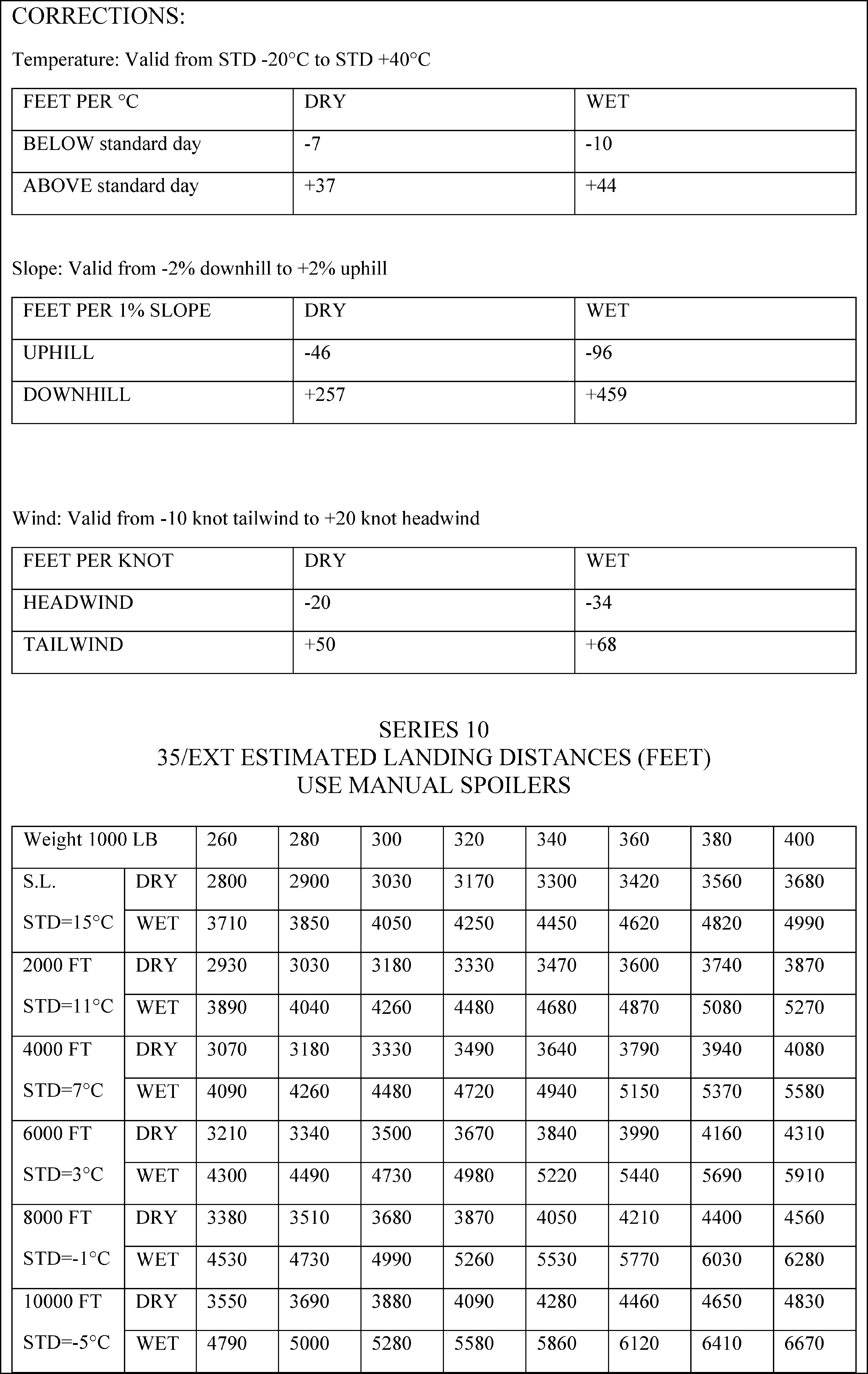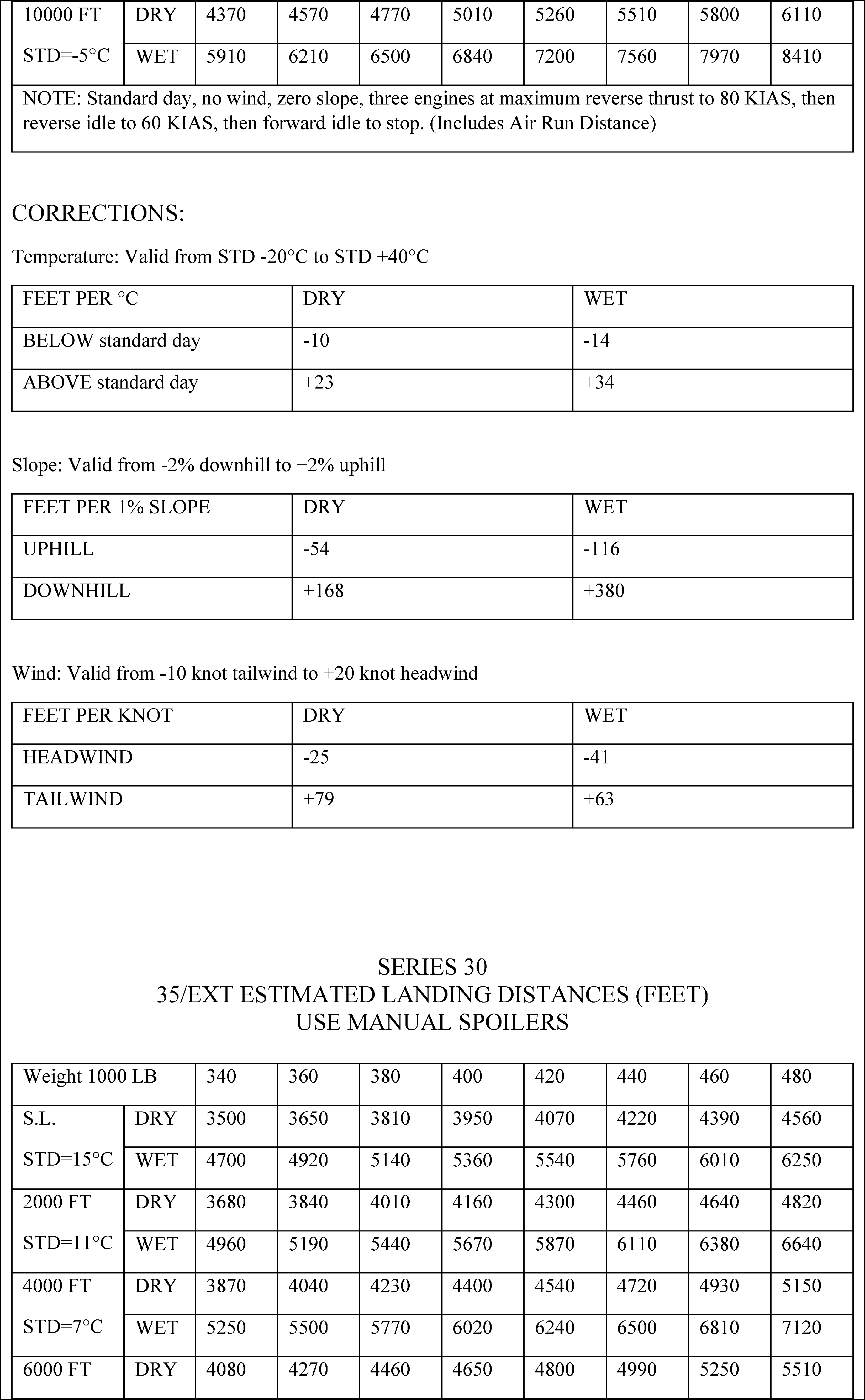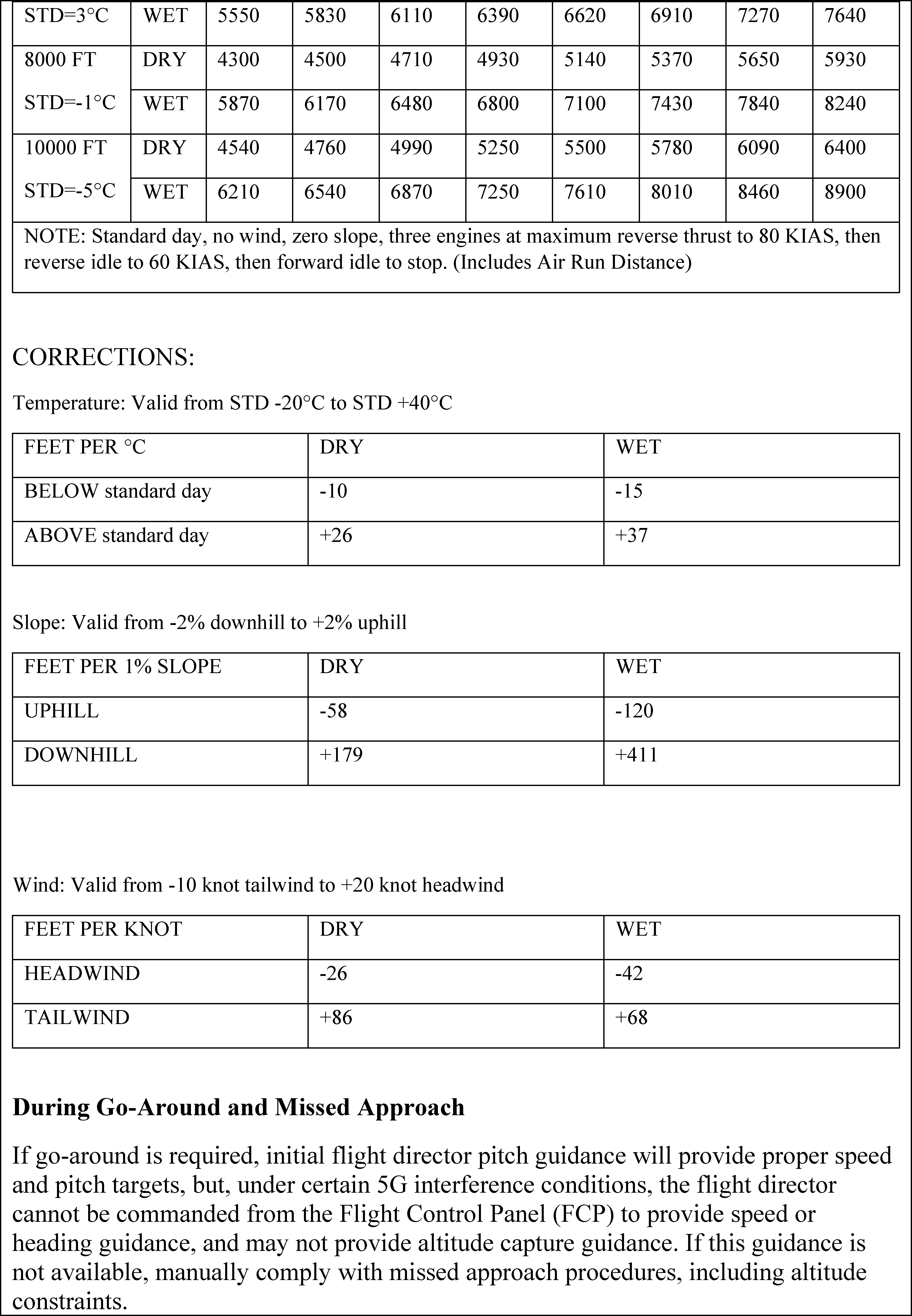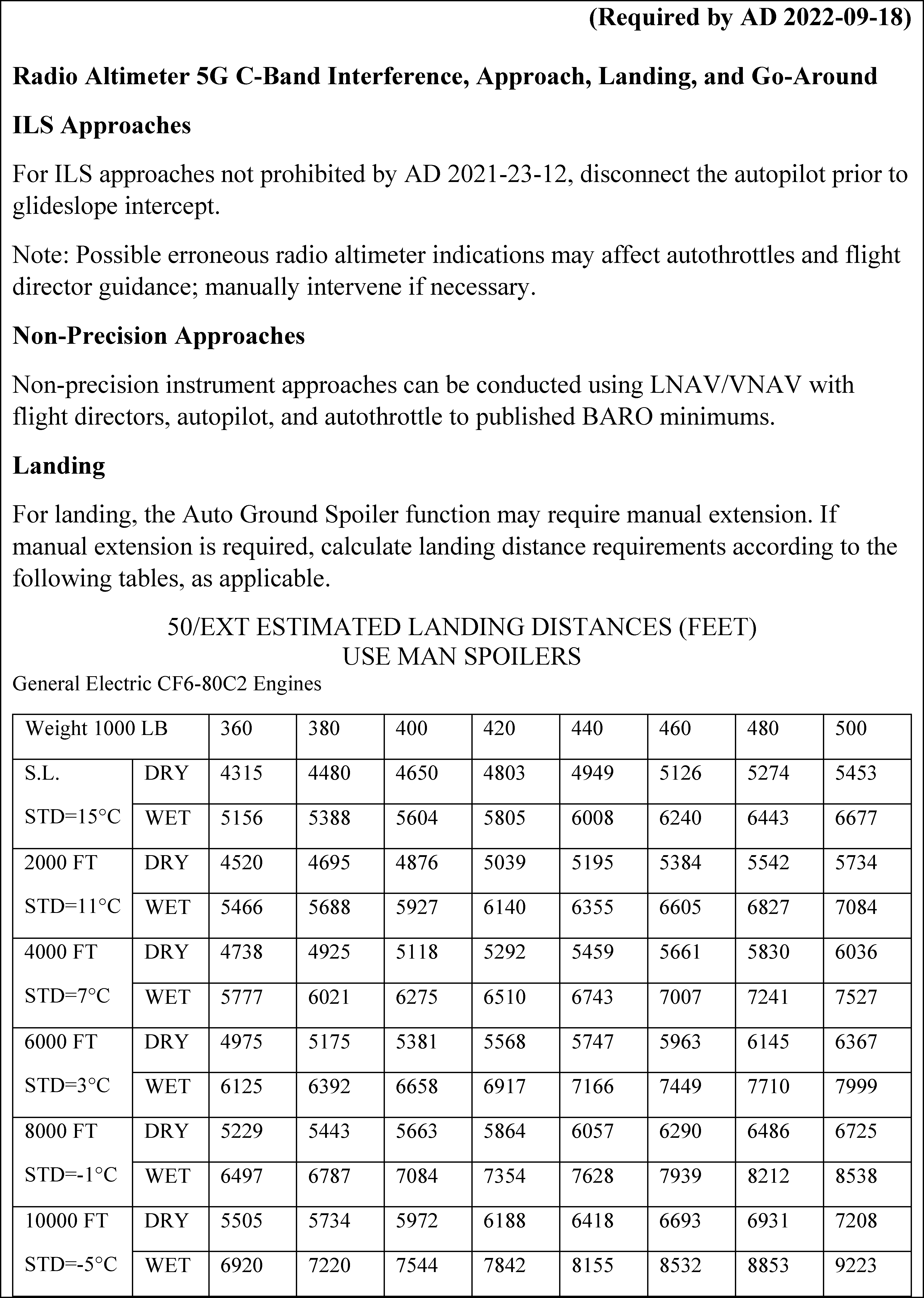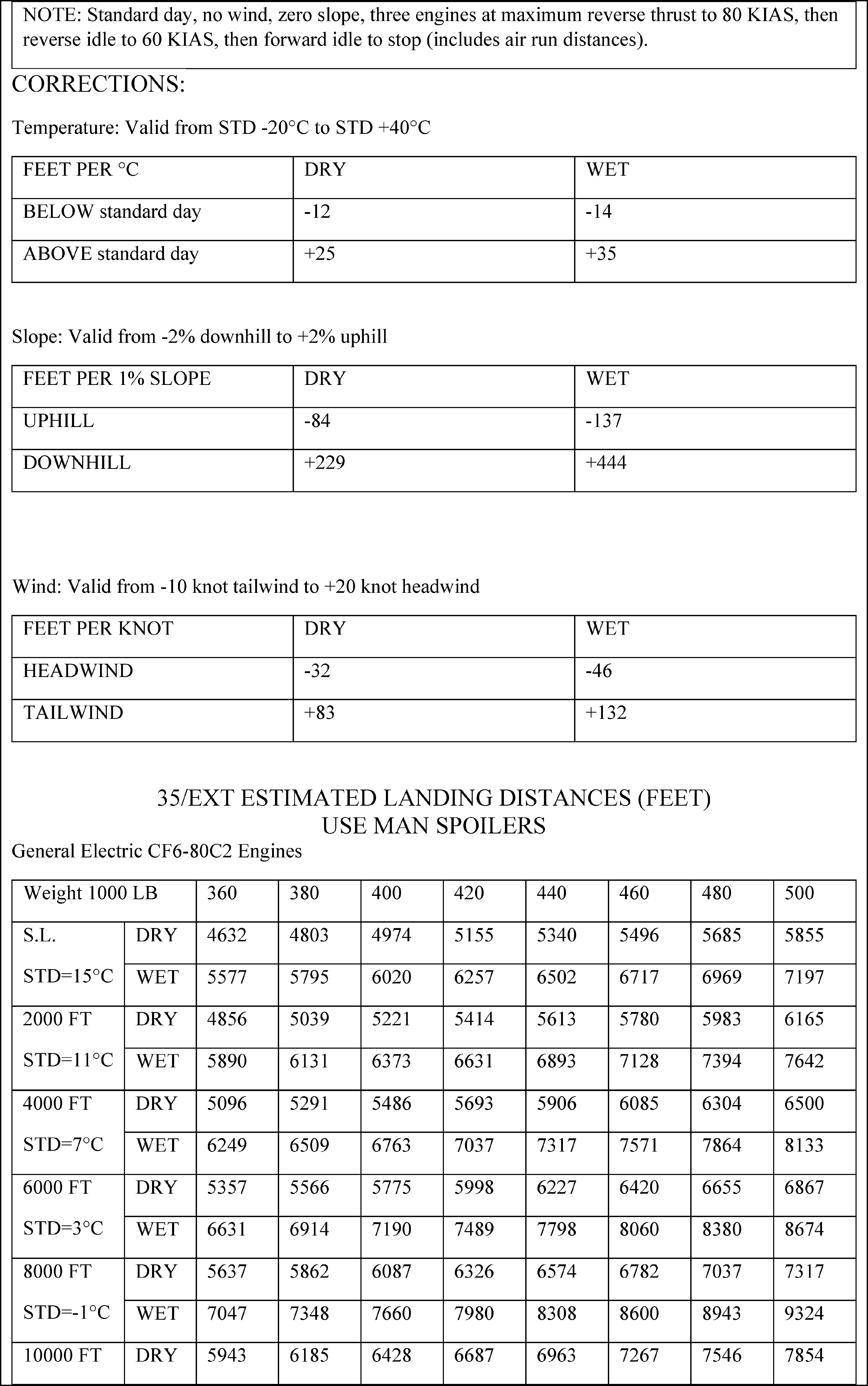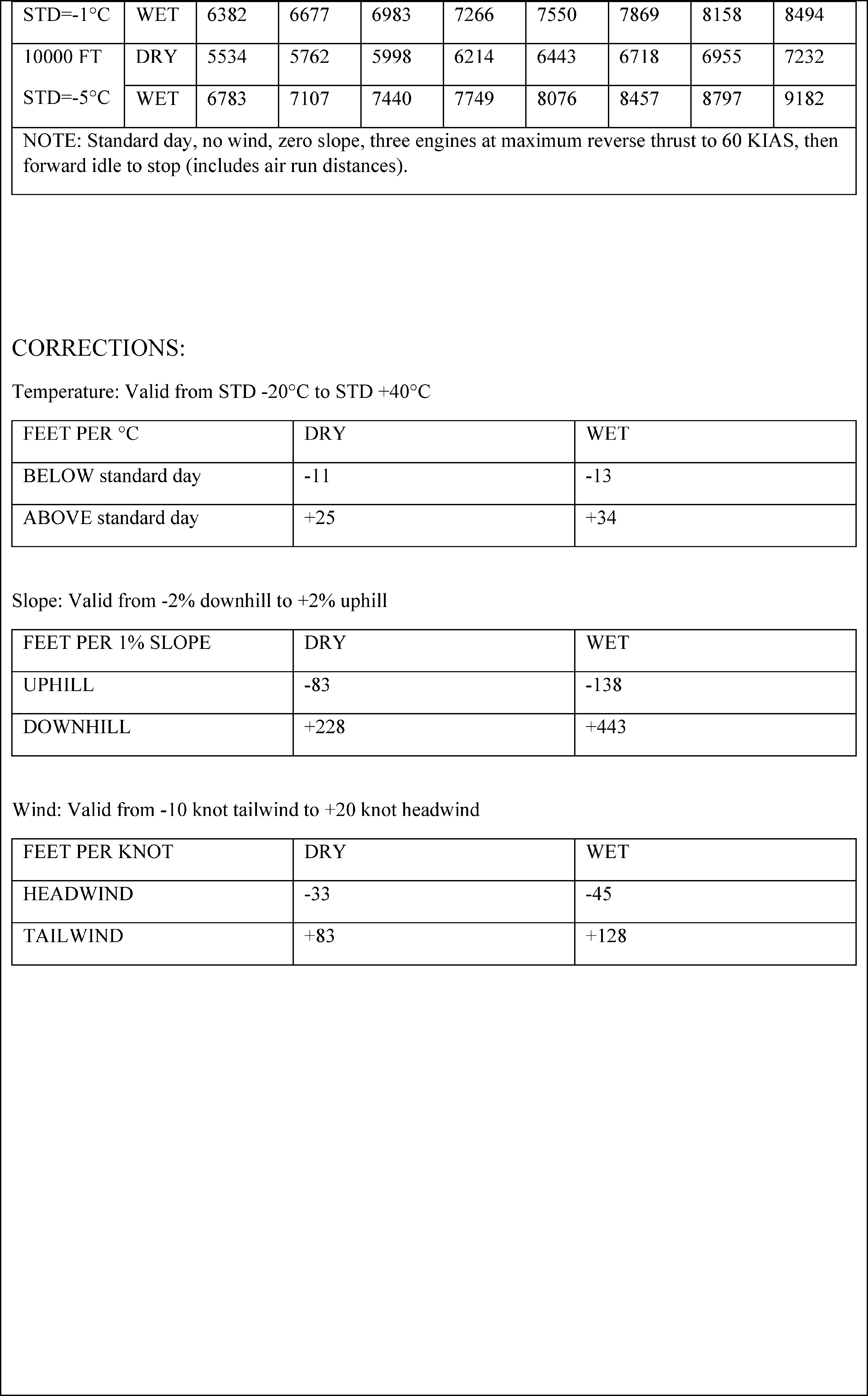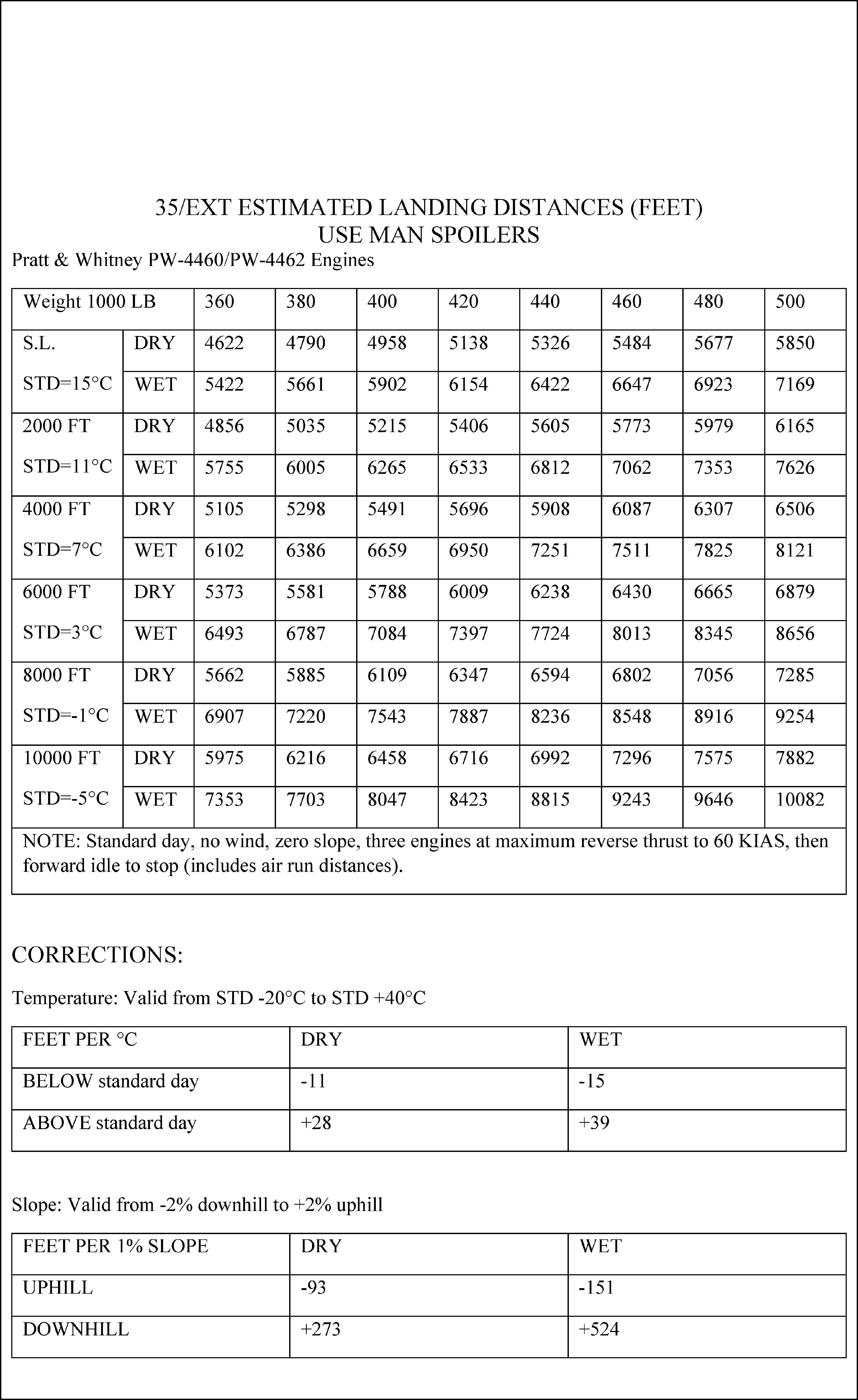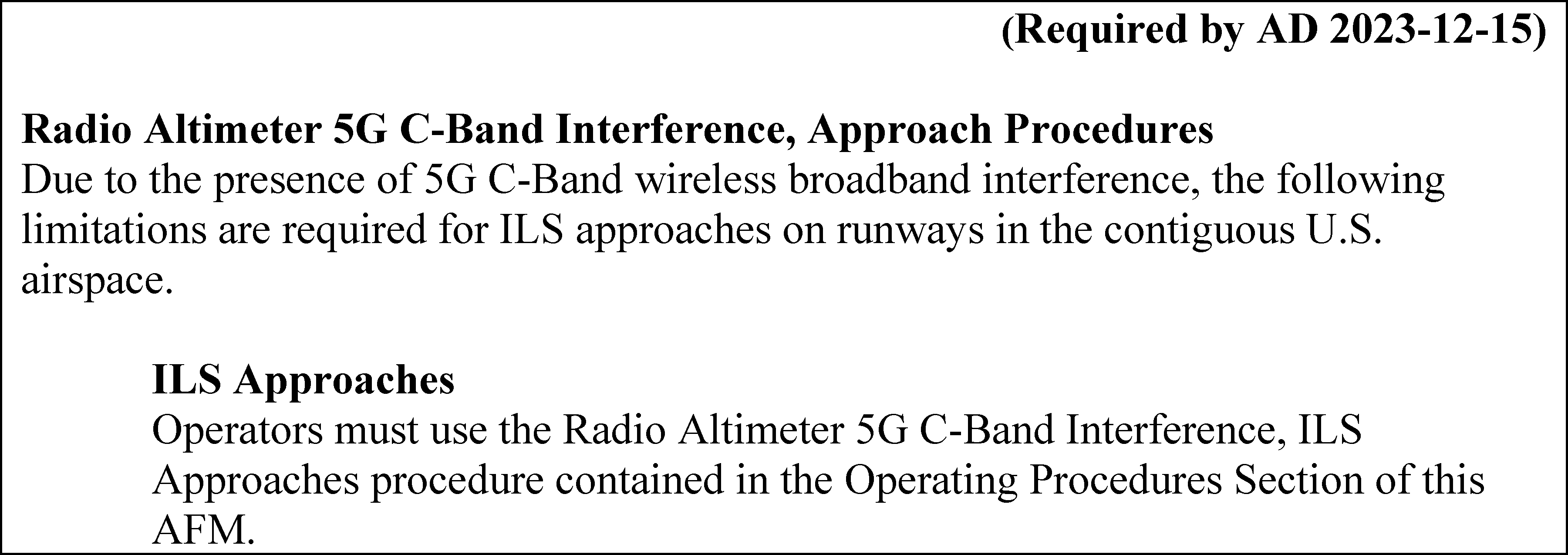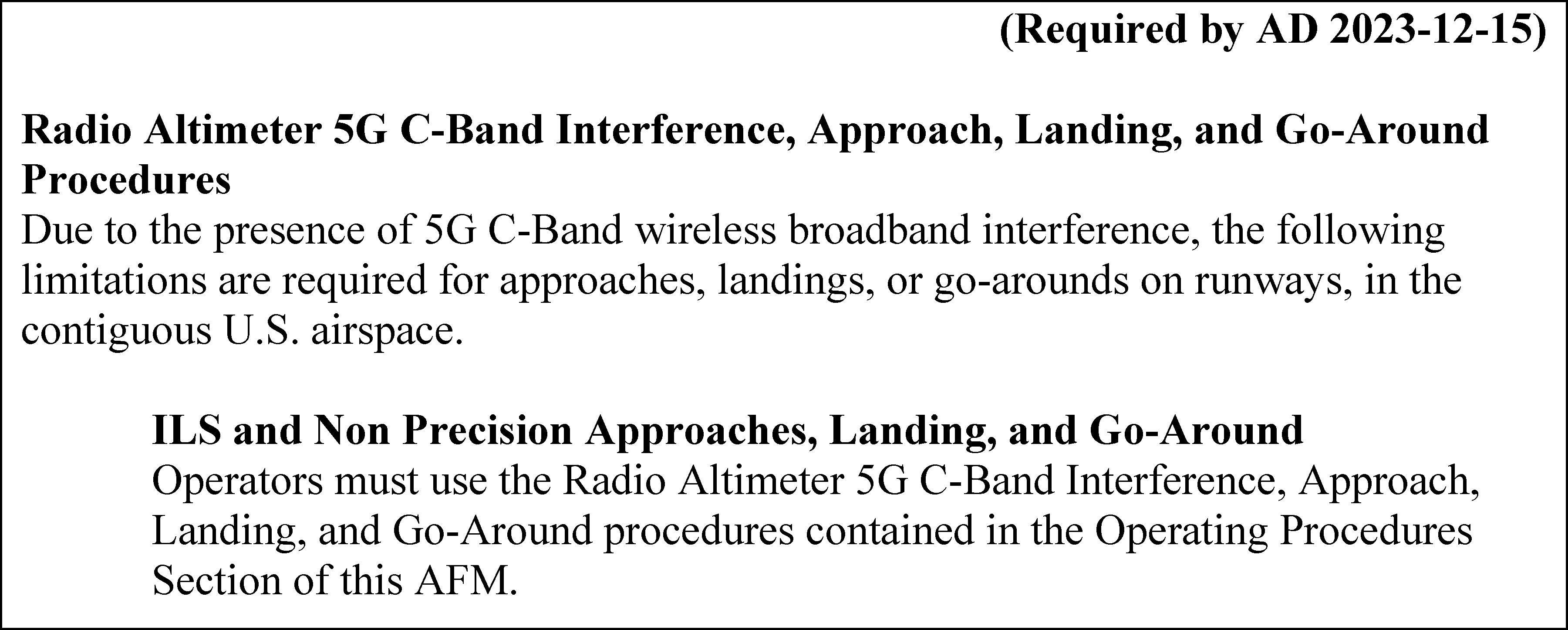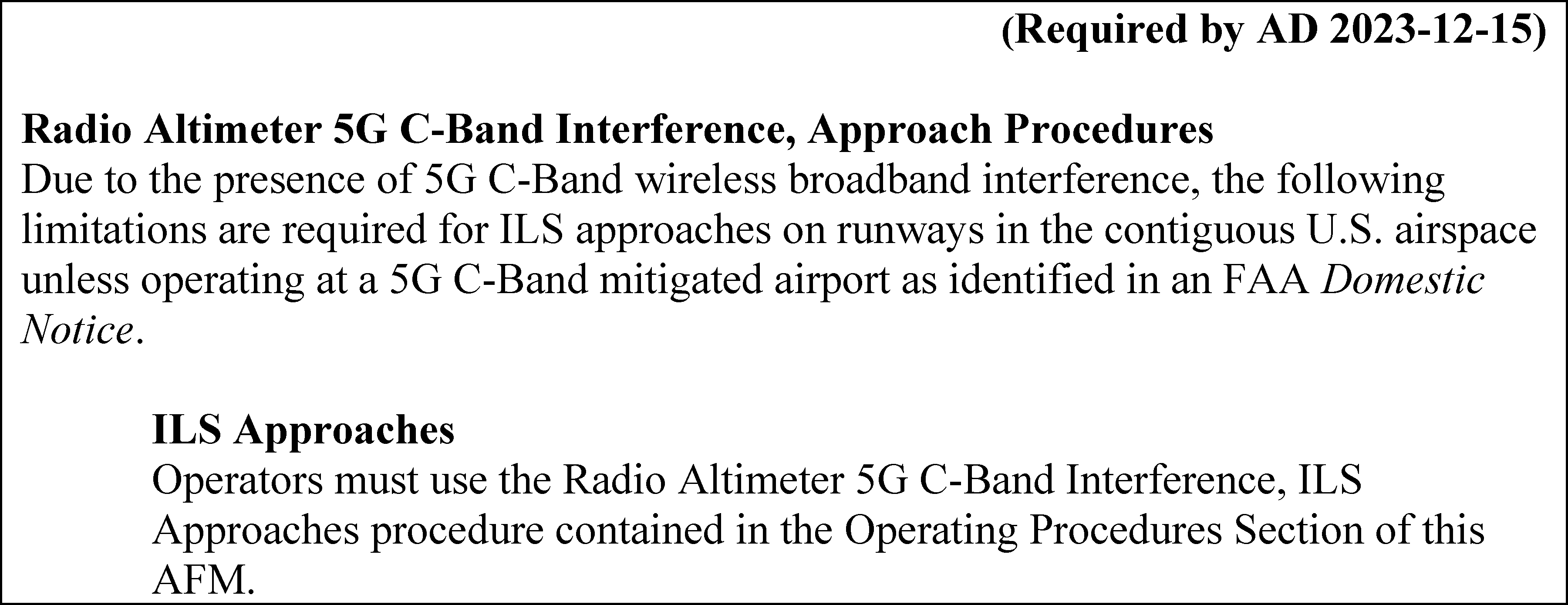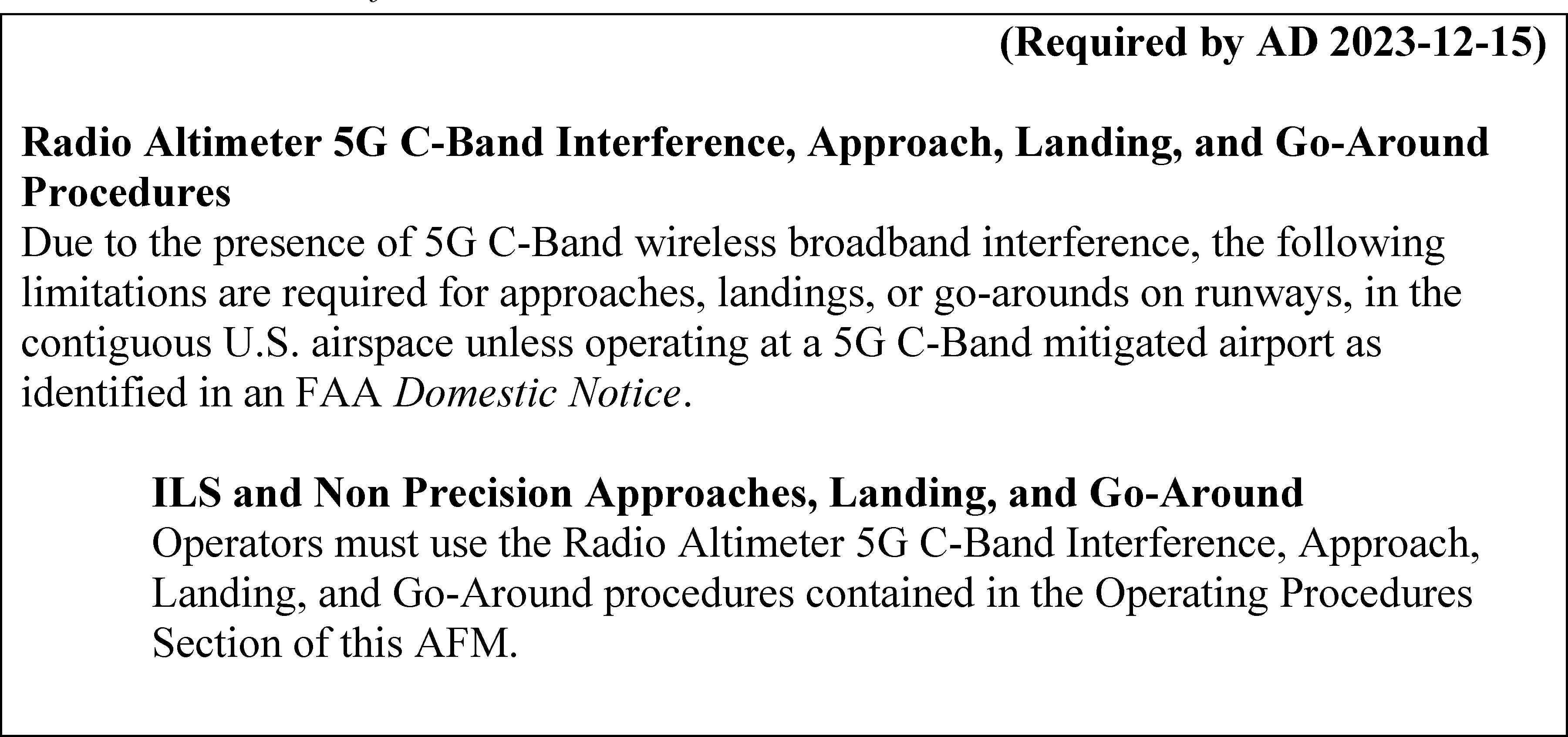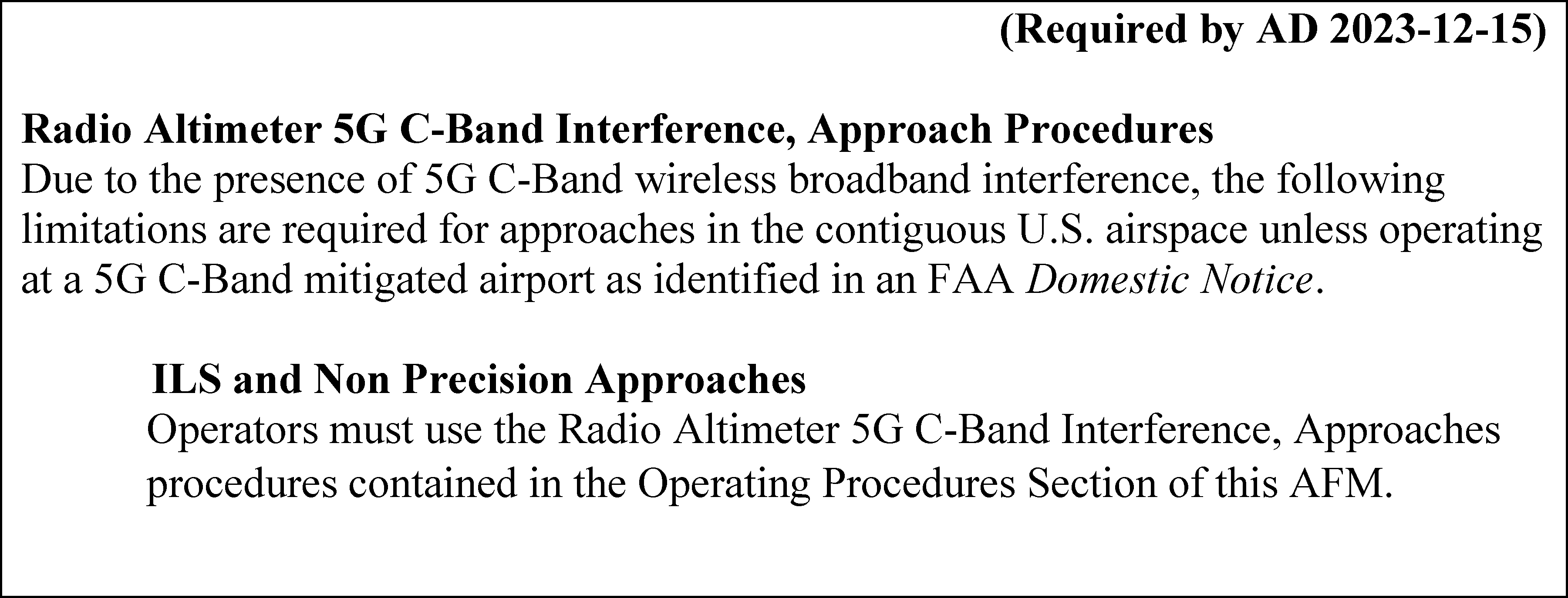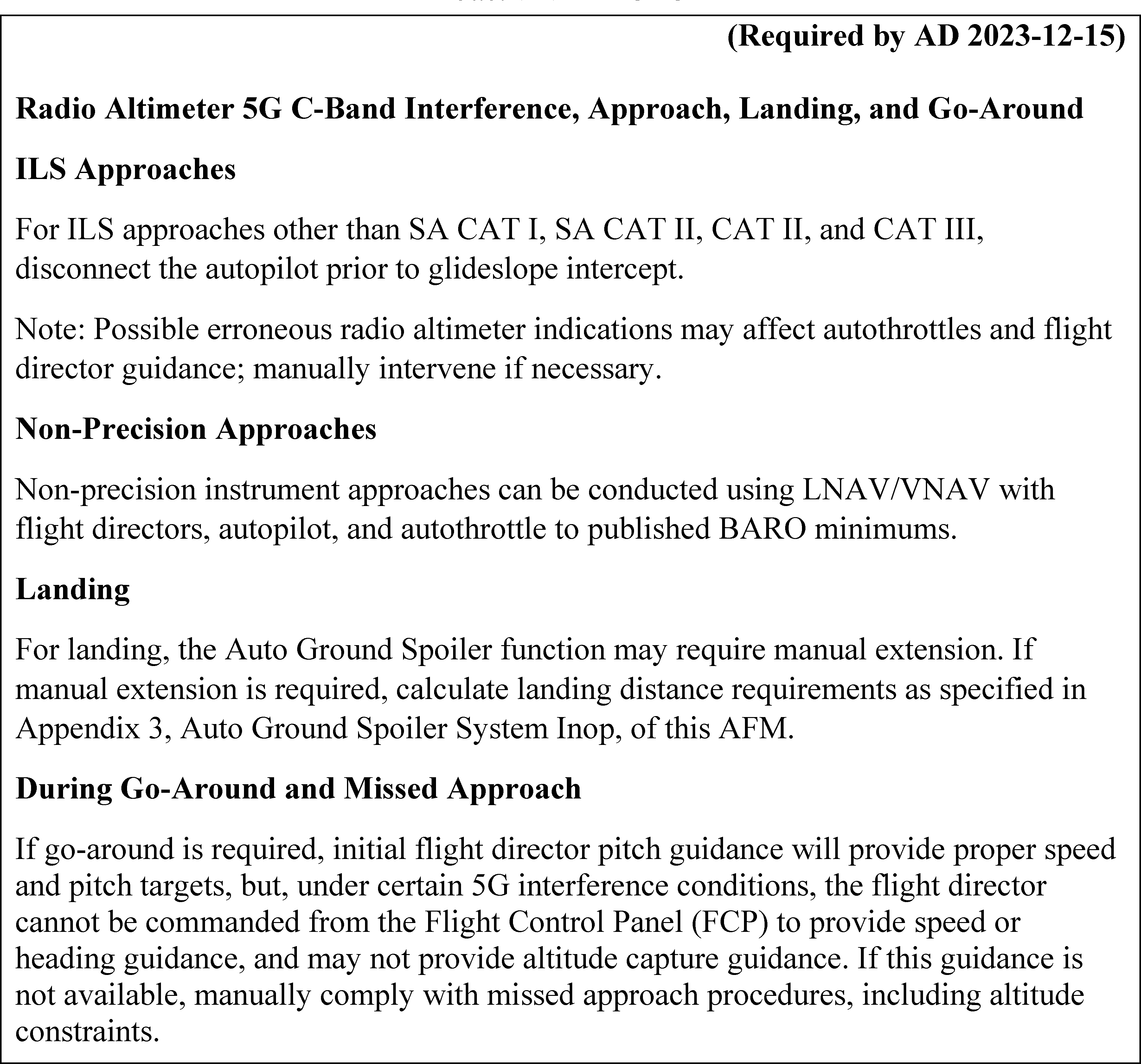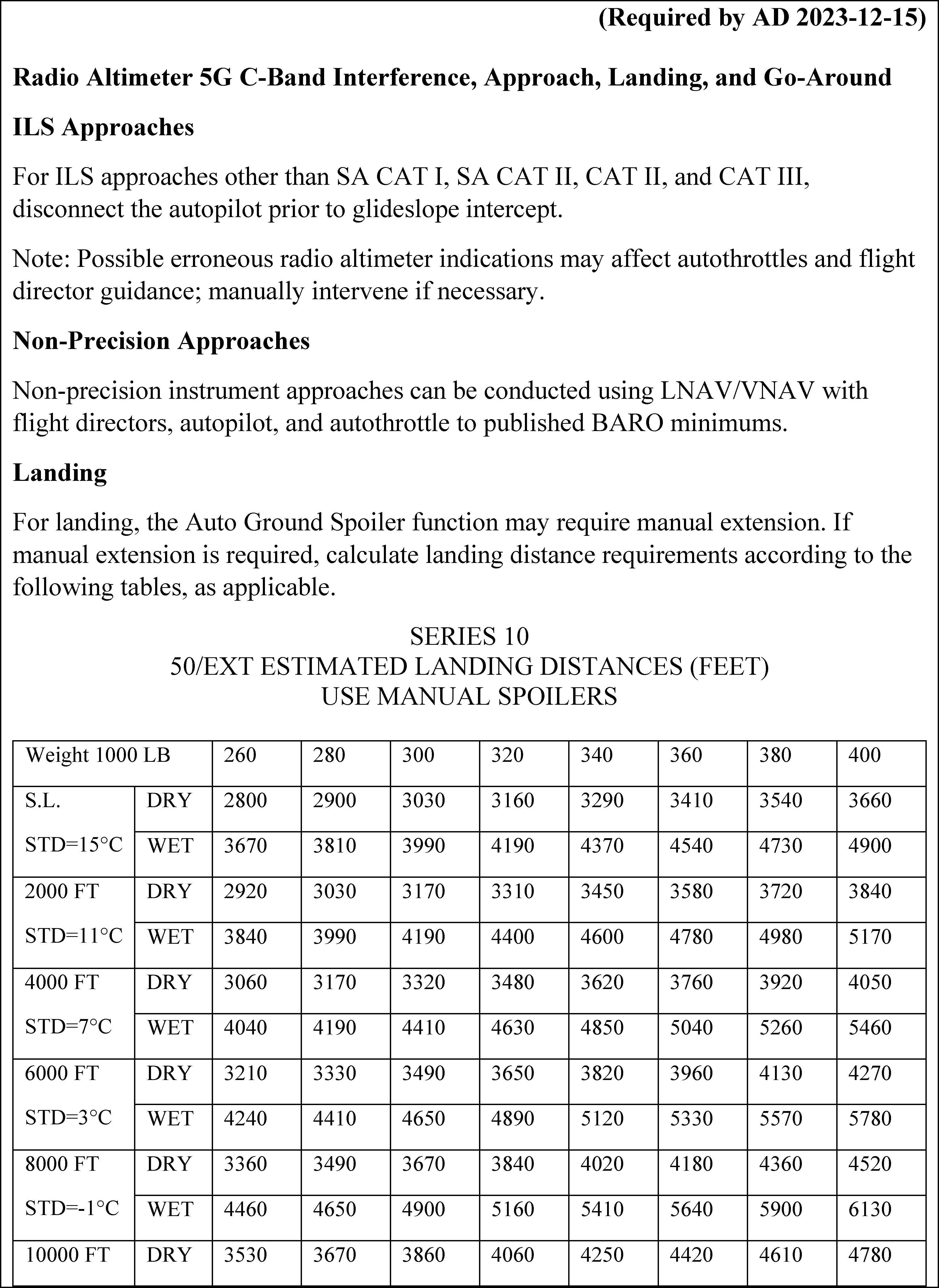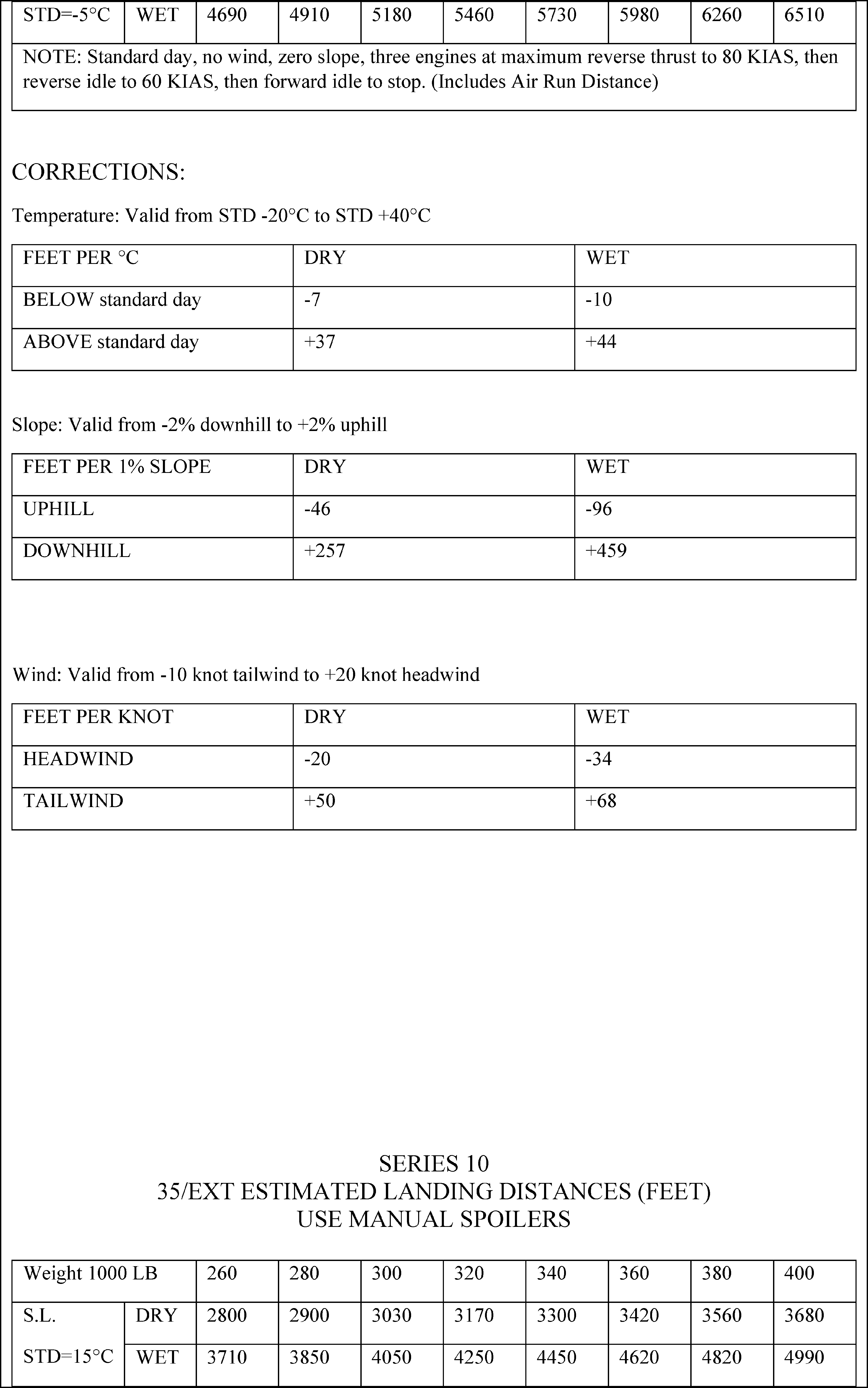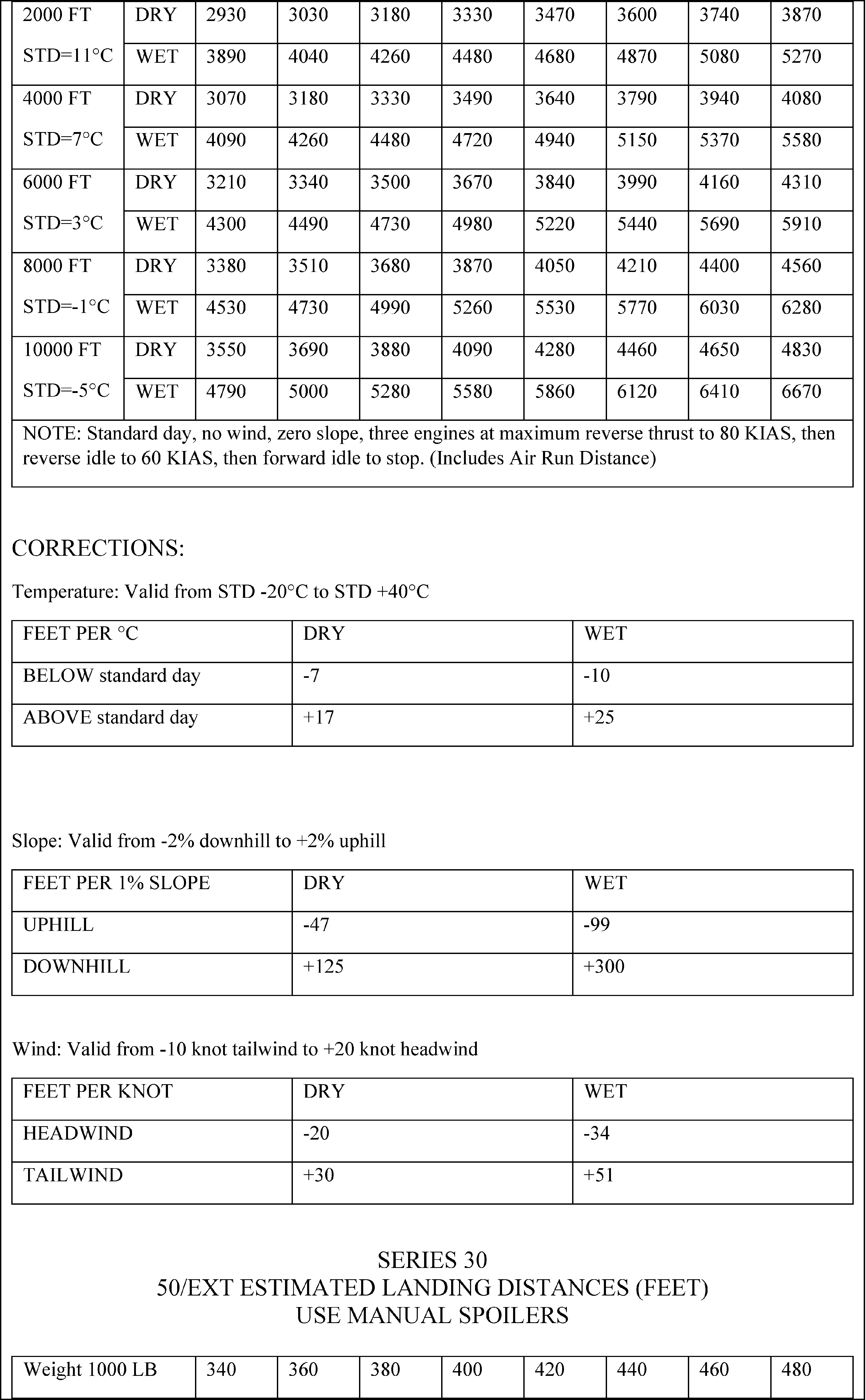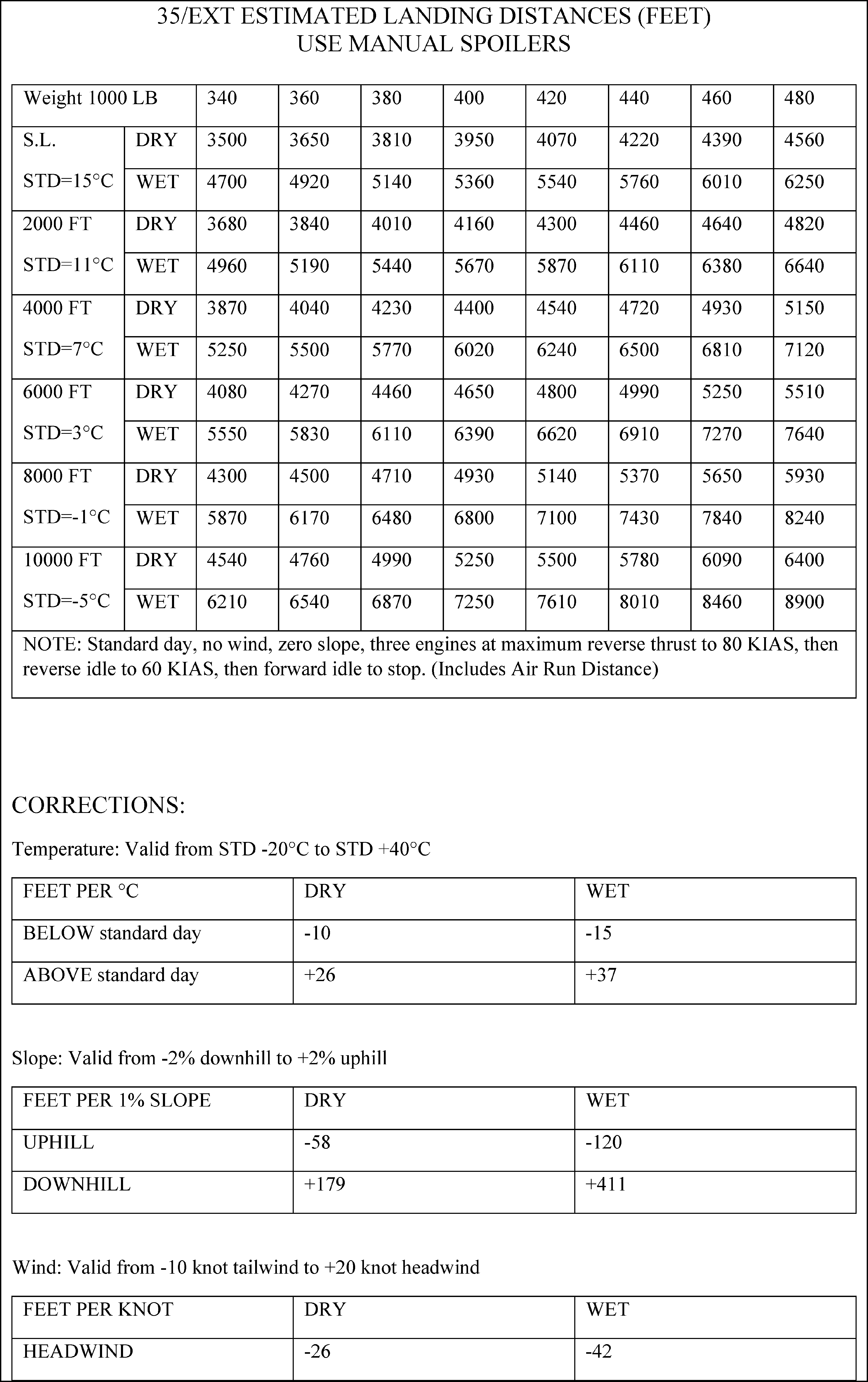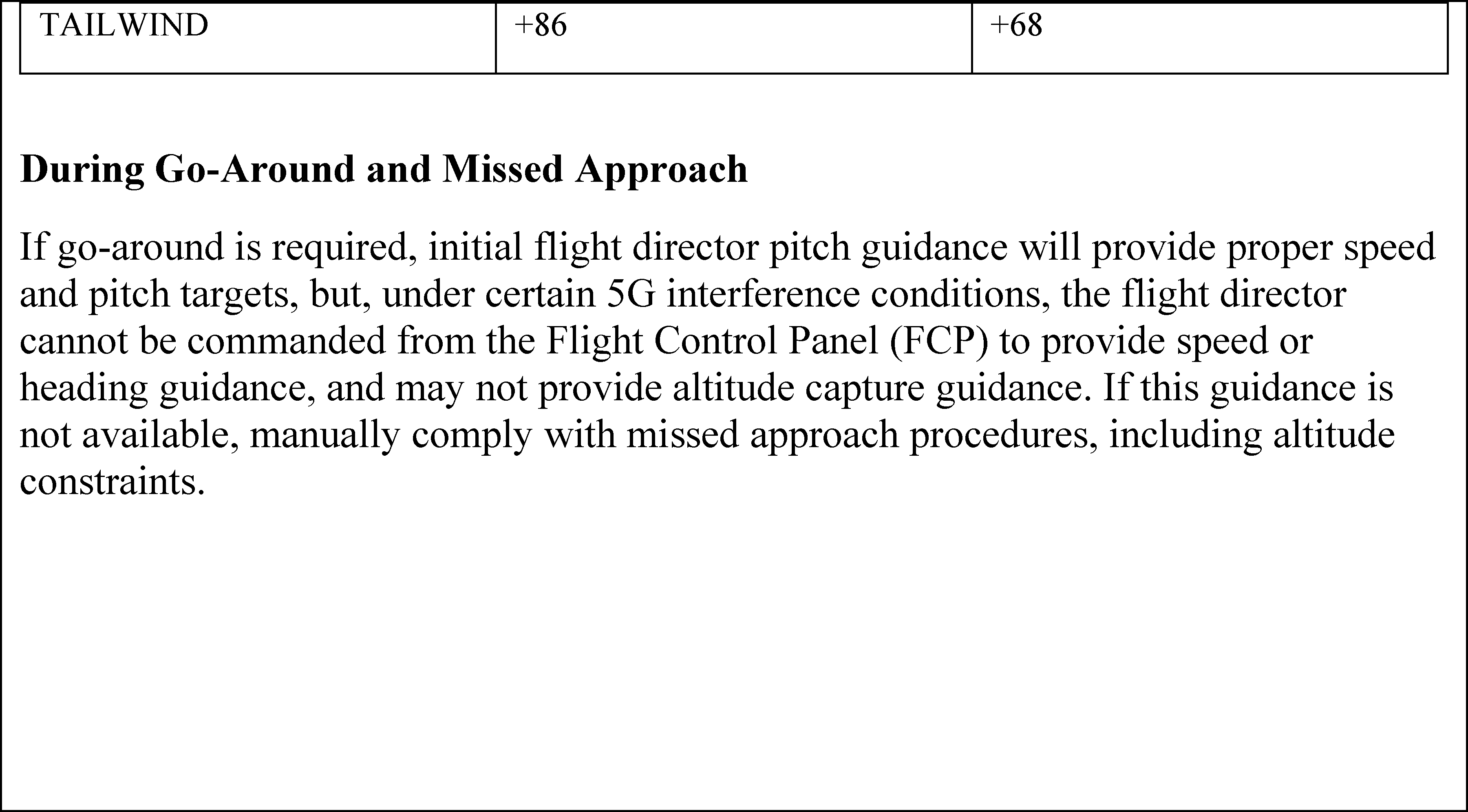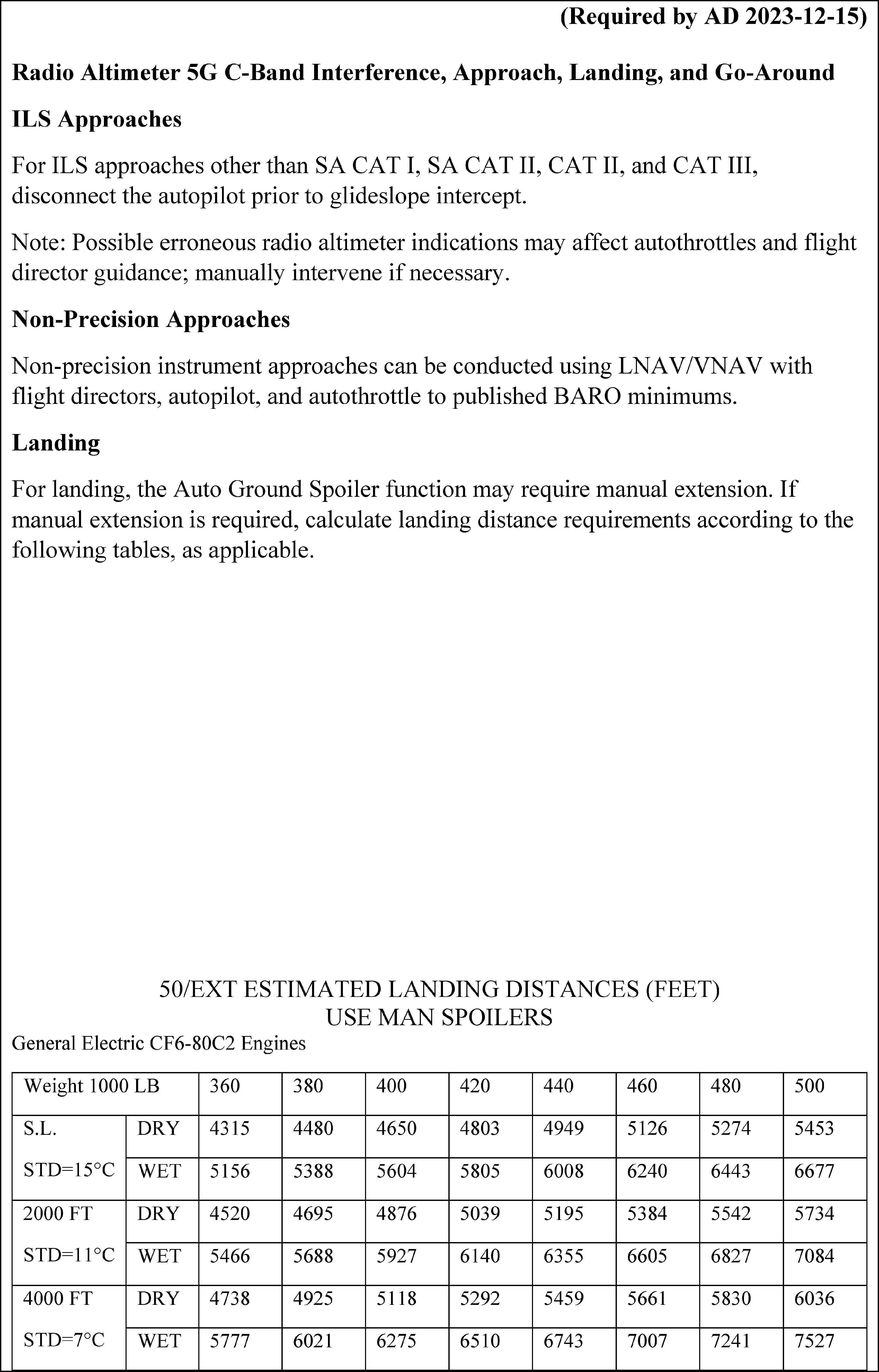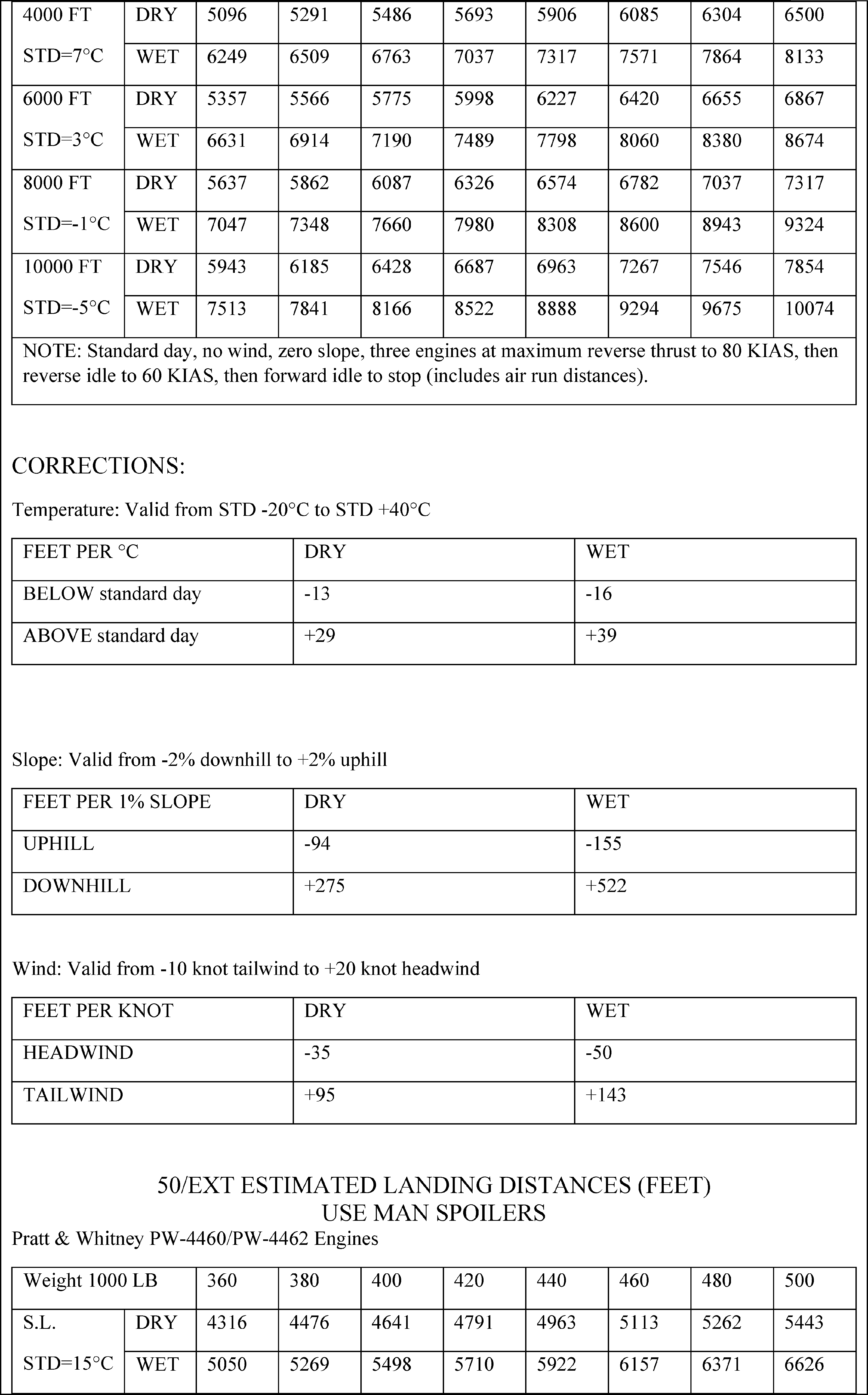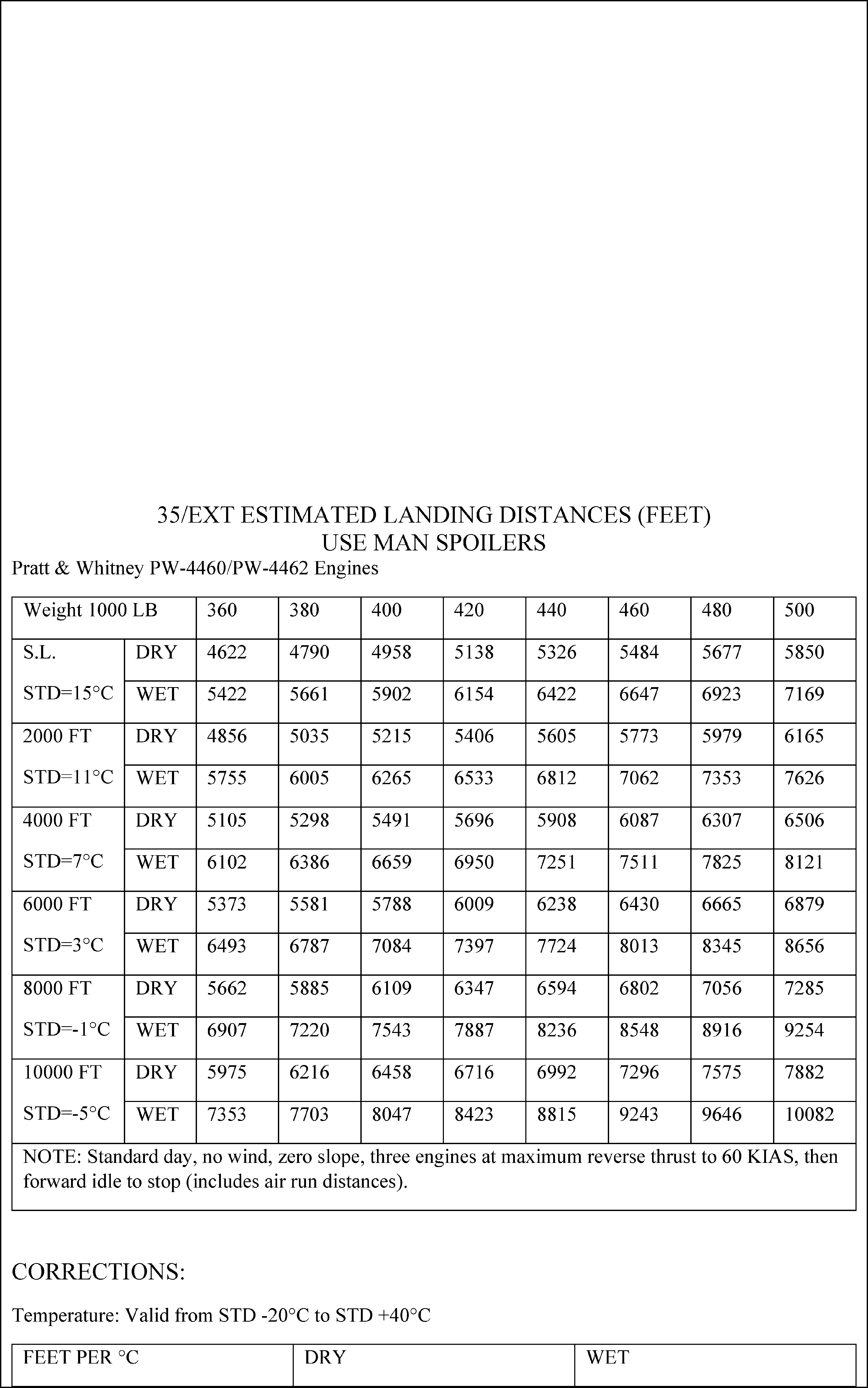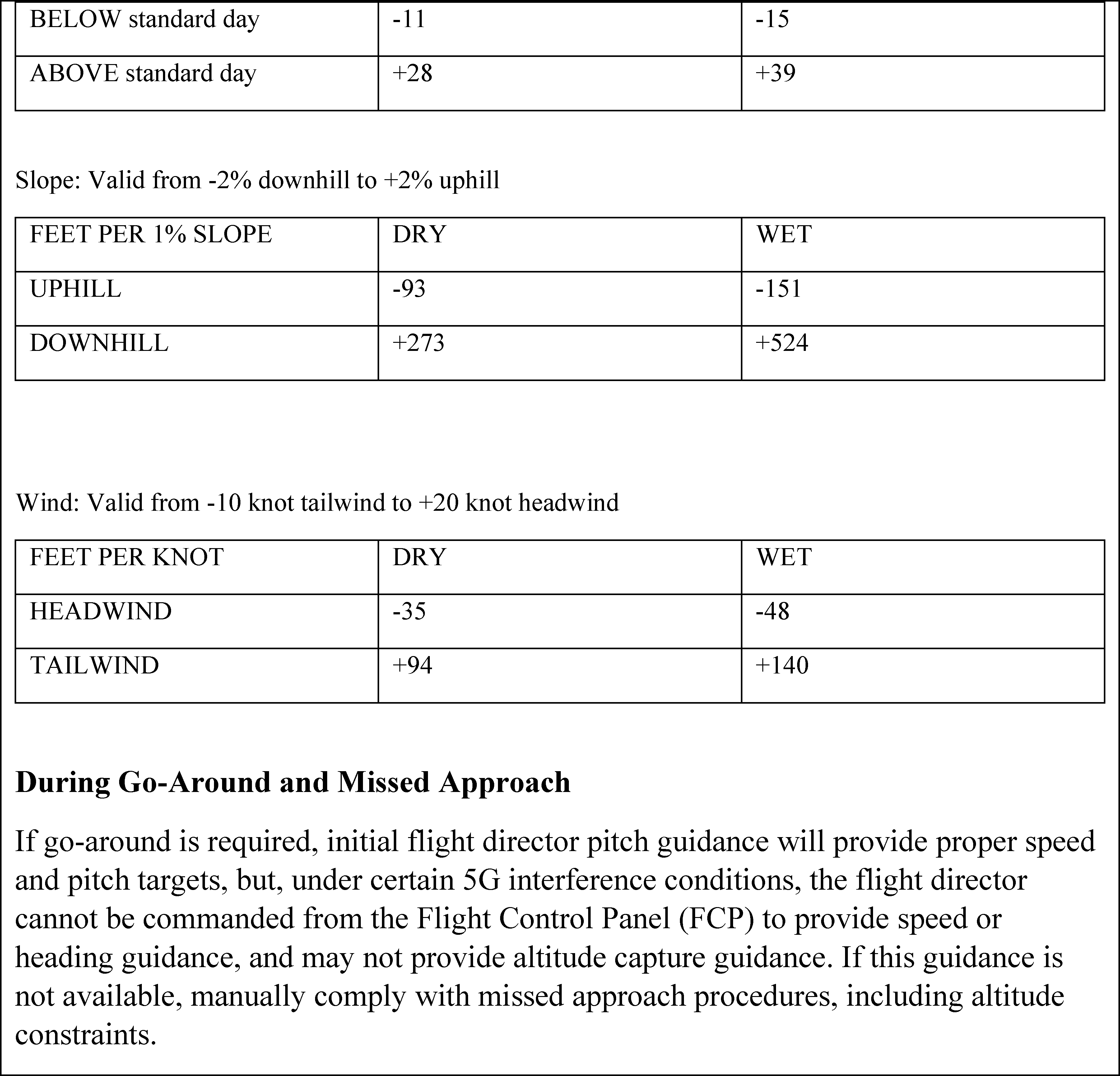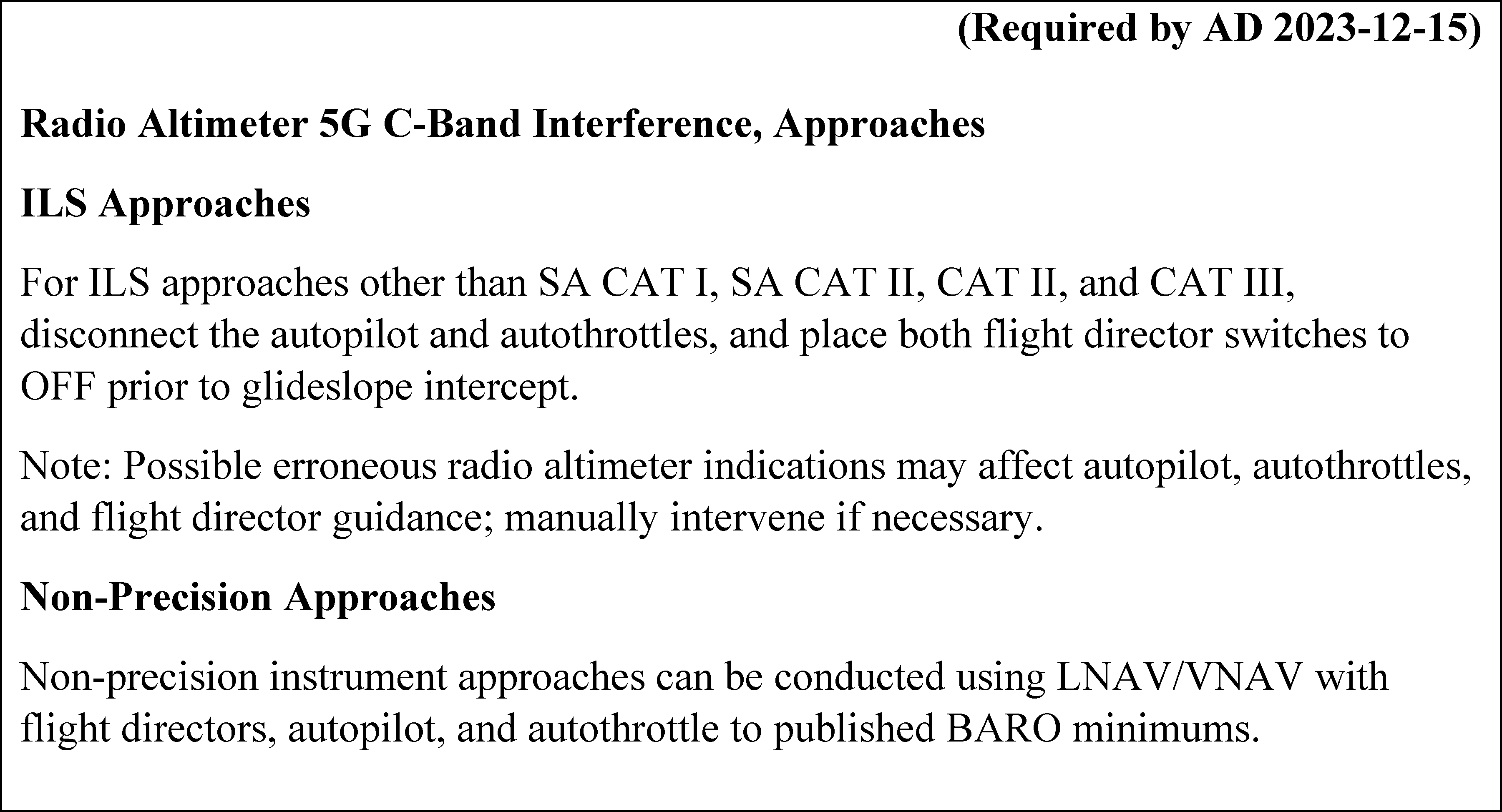-
Start Preamble
AGENCY:
Federal Aviation Administration (FAA), DOT.
ACTION:
Final rule.
SUMMARY:
The FAA is superseding Airworthiness Directive (AD) 2022–09–18, which applied to all The Boeing Company Model 707, 717, and 727 airplanes; Model DC–8, DC–9, and DC–10 airplanes; Model MD–10 and MD–11 airplanes; Model DC–9–81 (MD–81), DC–9–82 (MD–82), DC–9–83 (MD–83), DC–9–87 (MD–87), and MD–88 airplanes; and Model MD 90–30 airplanes. AD 2022–09–18 required revising the limitations and operating procedures sections of the existing airplane flight manual (AFM) to incorporate specific operating procedures for, depending on the airplane model, instrument landing system (ILS) approaches, non-precision approaches, ground spoiler deployment, and go-around and missed approaches, when in the presence of interference from wireless broadband operations in the 3.7–3.98 GHz frequency band (5G C-Band) as identified by Notices to Air Missions (NOTAMs). Since the FAA issued AD 2022–09–18, the FAA determined that additional limitations are needed due to the continued deployment of new 5G C-Band stations whose signals are expected to cover most of the contiguous United States at transmission frequencies between 3.7–3.98 GHz. This AD requires revising the limitations and operating procedures Start Printed Page 40024 sections of the AFM to incorporate specific operating procedures for, depending on the airplane model, ILS approaches, non-precision approaches, ground spoiler deployment, and go-around and missed approaches, due to the presence of 5G C-Band interference. The FAA is issuing this AD to address the unsafe condition on these products.
DATES:
This AD is effective June 21, 2023.
ADDRESSES:
AD Docket: You may examine the AD docket at regulations.gov under Docket No. FAA–2023–0923; or in person at Docket Operations between 9 a.m. and 5 p.m., Monday through Friday, except Federal holidays. The AD docket contains this final rule, any comments received, and other information. The address for Docket Operations is U.S. Department of Transportation, Docket Operations, M–30, West Building Ground Floor, Room W12–140, 1200 New Jersey Avenue SE, Washington, DC 20590.
Start Further InfoFOR FURTHER INFORMATION CONTACT:
Brett Portwood, Continued Operational Safety Technical Advisor, COS Program Management Section, Operational Safety Branch, FAA, 3960 Paramount Boulevard, Lakewood, CA 90712–4137; phone: 817–222–5390; email: operationalsafety@faa.gov.
End Further Info End Preamble Start Supplemental InformationSUPPLEMENTARY INFORMATION:
Background
The FAA issued a notice of proposed rulemaking (NPRM) to amend 14 CFR part 39 to supersede AD 2022–09–18, Amendment 39–22038 (87 FR 31097, May 23, 2022) (AD 2022–09–18). AD 2022–09–18 applied to all The Boeing Company (Boeing) Model 707, 717, and 727 airplanes; Model DC–8, DC–9, and DC–10 airplanes; Model MD–10 and MD–11 airplanes; Model DC–9–81 (MD–81), DC–9–82 (MD–82), DC–9–83 (MD–83), DC–9–87 (MD–87), and MD–88 airplanes; and Model MD 90–30 airplanes. The NPRM published in the Federal Register on May 3, 2023 (88 FR 27749). The NPRM was prompted by a determination that radio altimeters cannot be relied upon to perform their intended function if they experience 5G C-Band interference, and a determination that during approach, landings, and go-arounds, as a result of this interference, certain airplane systems may not properly function, resulting in increased flightcrew workload while on approach with the flight director, autothrottle, or autopilot engaged.
In the NPRM, the FAA proposed to retain the AFM revisions required by AD 2022–09–18 until June 30, 2023. On or before June 30, 2023, the FAA proposed to require replacing those AFM revisions with limitations requiring the same procedures for, depending on the airplane model, ILS approaches, non-precision approaches, ground spoiler deployment, and go-around and missed approaches, at all airports for non-radio altimeter tolerant airplanes. For radio altimeter tolerant airplanes, the FAA proposed that the procedures would not be required at 5G C-Band mitigated airports (5G CMAs) as identified in an FAA Domestic Notice. The FAA proposed this AD to address 5G C-Band interference that could result in increased flightcrew workload and could lead to reduced ability of the flightcrew to maintain safe flight and landing of the airplane.
Discussion of Final Airworthiness Directive
Comments
The FAA provided the public with an opportunity to comment on the proposed AD and received comments from three commenters. The following presents the comments received on the NPRM and the FAA's response to each comment.
Support for NPRM
Boeing and the Air Line Pilots Association, International (ALPA), supported the NPRM without change.
The supportive comments from ALPA included additional viewpoints without a suggestion specific to the AD or a request the FAA can act on. These comments are outside the scope of this final rule.
Request To Extend Compliance Time
Comment summary: American Airlines expressed concern regarding the compliance time for the proposed actions and requested the FAA revise the AD to provide a minimum of 30 days from the effective date of the AD.
FAA response: The FAA understands the commenter's concern and made every effort to publish this AD as soon as possible. After refraining from operating at their FCC-authorized levels for a year and a half, wireless companies are now able to operate at higher levels, yet still not at the levels authorized. Specifically, wireless companies expect to operate their networks in urban areas with minimal restrictions due to the completion of retrofits. Additionally, the FAA anticipates 19 additional telecommunication companies will begin transmitting in the C-Band after June 30, 2023. Although the FAA continues to work with the companies that intend to transmit in the 3.7–3.98–GHz band near 5G CMAs, the FAA has no agreement with those companies to provide the FAA with tower locations and other information necessary to support the current NOTAM/AMOC process. Therefore, the FAA will not be able to extend the June 30, 2023, date.
Conclusion
The FAA reviewed the relevant data, considered any comments received, and determined that air safety requires adopting this AD as proposed. Accordingly, the FAA is issuing this AD to address the unsafe condition on these products. This AD is adopted as proposed in the NPRM.
Interim Action
The FAA considers this AD to be an interim action. Once the Technical Standard Order (TSO) standard for radio altimeters is established, which will follow the existing international technical consensus on the establishment of the minimum operational performance standards (MOPS), the FAA anticipates that the MOPS will be incorporated into the TSO. Once a new radio altimeter TSO is developed, approved, and available, the FAA might consider additional rulemaking.
Effective Date
Section 553(d) of the Administrative Procedure Act (APA) (5 U.S.C. 551 et seq.) requires publication of a rule not less than 30 days before its effective date. However, section 553(d) authorizes agencies to make rules effective in less than 30 days when the agency finds “good cause.” Radio altimeters cannot be relied upon to perform their intended function if they experience interference from wireless broadband operations in the 5G C-Band. This interference can cause other airplane systems to not properly function, resulting in increased flightcrew workload while on approach with the flight director, autothrottle, or autopilot engaged. To address this unsafe condition, the actions required by this AD must be accomplished before the compliance date of June 30, 2023. The FAA based this date on the changes to the 5G C-Band environment beginning on July 1, 2023. These changes include increased wireless broadband deployment and transmissions closer to the parameters authorized by the FCC. The earlier operators learn of the requirements in this AD, the earlier they can take action to ensure compliance. An effective date less than 30 days would ensure the AD is codified earlier, thereby increasing awareness of its requirements. Therefore, the FAA finds that good cause exists pursuant to 5 U.S.C. 553(d) Start Printed Page 40025 for making this amendment immediately effective.
Costs of Compliance
The cost information below describes the costs to change the AFM. Although this AD largely maintains the AFM limitations currently required by AD 2022–09–18, the FAA acknowledges that this AD may also impose costs on some aircraft operators from having to change their conduct to comply with the amended AFM. However, the FAA lacks the data necessary to quantify the costs associated with aircraft operators changing their conduct.
The FAA estimates that this AD affects 476 airplanes of U.S. registry. The FAA estimates the following costs to comply with this AD:
Estimated Costs
Action Labor cost Parts cost Cost per product Cost on U.S. operators AFM revision (retained actions from AD 2022–09–18) 1 work-hour × $85 per hour 1 = $85 $0 $85 $40,460 New AFM revisions (new action) 1 work-hour × $85 per hour = $85 0 85 2 40,460 1 The labor rate of $85 per hour is the average wage rate for an aviation mechanic. 2 The estimated cost for this revision would not constitute a significant economic impact (even for small entities) because $85 is a minimal cost compared to the regular costs of maintaining and operating a 707, 717, 727, DC–8, DC–9, DC–10, MD 10, MD–11, DC–9–81, DC–9–82, DC–9–83, DC–9–87, MD–88, or MD–90–30 transport category airplane. Authority for This Rulemaking
Title 49 of the United States Code specifies the FAA's authority to issue rules on aviation safety. Subtitle I, section 106, describes the authority of the FAA Administrator. Subtitle VII: Aviation Programs, describes in more detail the scope of the Agency's authority.
The FAA is issuing this rulemaking under the authority described in Subtitle VII, Part A, Subpart III, Section 44701: General requirements. Under that section, Congress charges the FAA with promoting safe flight of civil aircraft in air commerce by prescribing regulations for practices, methods, and procedures the Administrator finds necessary for safety in air commerce. This regulation is within the scope of that authority because it addresses an unsafe condition that is likely to exist or develop on products identified in this rulemaking action.
Regulatory Findings
This AD will not have federalism implications under Executive Order 13132. This AD will not have a substantial direct effect on the States, on the relationship between the national government and the States, or on the distribution of power and responsibilities among the various levels of government.
For the reasons discussed above, I certify that this AD:
(1) Is not a “significant regulatory action” under Executive Order 12866,
(2) Will not affect intrastate aviation in Alaska, and
(3) Will not have a significant economic impact, positive or negative, on a substantial number of small entities under the criteria of the Regulatory Flexibility Act.
Start List of SubjectsList of Subjects in 14 CFR Part 39
- Air transportation
- Aircraft
- Aviation safety
- Incorporation by reference
- Safety
The Amendment
Accordingly, under the authority delegated to me by the Administrator, the FAA amends 14 CFR part 39 as follows:
Start PartPART 39—AIRWORTHINESS DIRECTIVES
End Part Start Amendment Part1. The authority citation for part 39 continues to read as follows:
End Amendment PartStart Amendment Part[Amended]2. The FAA amends § 39.13 by:
End Amendment Part Start Amendment Parta. Removing Airworthiness Directive (AD) 2022–09–18, Amendment 39–22038 ( 87 FR 31097, May 23, 2022), and
End Amendment Part Start Amendment Partb. Adding the following new AD:
End Amendment Part2023–12–15 The Boeing Company: Amendment 39–22473; Docket No. FAA–2023–0923; Project Identifier AD–2022–01432–T.
(a) Effective Date
This airworthiness directive (AD) is effective June 21, 2023.
(b) Affected ADs
This AD replaces AD 2022–09–18, Amendment 39–22038 (87 FR 31097, May 23, 2022) (AD 2022–09–18).
(c) Applicability
This AD applies to all The Boeing Company airplanes identified in paragraphs (c)(1) through (9) of this AD, certificated in any category.
(1) Model 707–100 Long Body, –200, –100B Long Body, and –100B Short Body series airplanes, and Model 707–300, –300B, –300C, and –400 series airplanes.
(2) Model 717–200 airplanes.
(3) Model 727, 727C, 727–100, 727–100C, 727–200, and 727–200F series airplanes.
(4) Model DC–8–11, DC–8–12, DC–8–21, DC–8–31, DC–8–32, DC–8–33, DC–8–41, DC–8–42, DC–8–43, DC–8–51, DC–8–52, DC–8–53, DC–8–55, DC–8F–54, DC–8F–55, DC–8–61, DC–8–62, DC–8–63, DC–8–61F, DC–8–62F, DC–8–63F, DC–8–71, DC–8–72, DC–8–73, DC–8–71F, DC–8–72F, and DC–8–73F airplanes.
(5) Model DC–9–11, DC–9–12, DC–9–13, DC–9–14, DC–9–15, DC–9–15F, DC–9–21, DC–9–31, DC–9–32, DC–9–32 (VC–9C), DC–9–32F, DC–9–32F (C–9A, C–9B), DC–9–33F, DC–9–34, DC–9–34F, DC–9–41, and DC–9–51 airplanes.
(6) Model DC–10–10, DC–10–10F, DC–10–15, DC–10–30, DC–10–30F (KC–10A and KDC–10), DC–10–40, and DC–10–40F airplanes.
(7) Model MD–10–10F and MD–10–30F airplanes.
(8) Model MD–11 and MD–11F airplanes.
(9) Model DC–9–81 (MD–81), DC–9–82 (MD–82), DC–9–83 (MD–83), DC–9–87 (MD–87), MD–88, and MD–90–30 airplanes.
(d) Subject
Air Transport Association (ATA) of America Code 34, Navigation.
(e) Unsafe Condition
This AD was prompted by a determination that radio altimeters cannot be relied upon to perform their intended function if they experience interference from wireless broadband operations in the 3.7–3.98 GHz frequency band (5G C-Band), and a determination that during approach, landings, and go-arounds, as a result of this interference, certain airplane systems may not properly function, resulting in increased flightcrew workload while on approach with the flight director, autothrottle, or autopilot engaged. The FAA is issuing this AD to address 5G C-Band interference that could result in increased flightcrew workload and could lead to reduced ability of the flightcrew to maintain safe flight and landing of the airplane.
(f) Compliance
Comply with this AD within the compliance times specified, unless already done.
(g) Definitions
(1) For purposes of this AD, a “5G C-Band mitigated airport” (5G CMA) is an airport at Start Printed Page 40026 which the telecommunications companies have agreed to voluntarily limit their 5G deployment at the request of the FAA, as identified by an FAA Domestic Notice.
(2) For purposes of this AD, a “radio altimeter tolerant airplane” is one for which the radio altimeter, as installed, demonstrates the tolerances specified in paragraphs (g)(2)(i) and (ii) of this AD, using a method approved by the FAA.
(i) Tolerance to radio altimeter interference, for the fundamental emissions (3.7–3.98 GHz), at or above the power spectral density (PSD) curve threshold specified in figure 1 to paragraph (g)(2)(i) of this AD.
Figure 1 to paragraph (g)(2)(i)— Fundamental Effective Isotropic PSD at Outside Interface of Aircraft Antenna
(ii) Tolerance to radio altimeter interference, for the spurious emissions (3.7–3.98 GHz), at or above the PSD curve threshold specified in figure 2 to paragraph (g)(2)(ii) of this AD.
Start Printed Page 40027Figure 2 to paragraph (g)(2)(ii)— Spurious Effective Isotropic PSD at Outside Interface of Aircraft Antenna
(3) For purposes of this AD, a “non-radio altimeter tolerant airplane” is one for which the radio altimeter, as installed, does not demonstrate the tolerances specified in paragraphs (g)(2)(i) and (ii) of this AD.
(h) Retained Airplane Flight Manual (AFM) Revision-Limitations
This paragraph restates the requirements of paragraph (g) of AD 2022–09–18.
(1) For airplanes identified in paragraphs (c)(1) and (c)(3) through (6) of this AD: Within 2 days after May 23, 2022 (the effective date of AD 2022–09–18), revise the Limitations Section of the existing AFM to include the information specified in figure 3 to paragraph (h)(1) of this AD. This may be done by inserting a copy of figure 3 to paragraph (h)(1) of this AD into the existing AFM.
Start Printed Page 40028Figure 3 to paragraph (h)(1)— AFM Limitations Revision for Model 707, 727, DC–8, DC–9 (except DC–9–81 (MD–81), DC–9–82 (MD–82), DC–9–83 (MD–83), and DC–9–87 (MD–87)), and DC–10
(2) For airplanes identified in paragraphs (c)(2), (7), and (8) of this AD: Within 2 days after May 23, 2022 (the effective date of AD 2022–09–18), revise the Limitations Section of the existing AFM to include the information specified in figure 4 to paragraph (h)(2) of this AD. This may be done by inserting a copy of figure 4 to paragraph (h)(2) of this AD into the Limitations Section of the existing AFM.
Figure 4 to paragraph (h)(2)— AFM Limitations Revision for Model 717, MD–10, and MD–11
(3) For airplanes identified in paragraph (c)(9) of this AD: Within 2 days after May 23, 2022 (the effective date of AD 2022–09–18), revise the Limitations Section of the existing AFM to include the information specified in figure 5 to paragraph (h)(3) of this AD. This may be done by inserting a copy of figure 5 to paragraph (h)(3) of this AD into the Limitations Section of the existing AFM.
Start Printed Page 40029Figure 5 to paragraph (h)(3)— AFM Limitations Revision for Model DC–9–81 (MD–81), DC–9–82 (MD–82), DC–9–83 (MD–83), DC–9–87 (MD–87), MD–88, and MD–90–30
(i) Retained AFM Revision-Operating Procedures
This paragraph restates the requirements of paragraph (h) of AD 2022–09–18.
(1) For airplanes identified in paragraphs (c)(1) and (3) through (6) of this AD: Within 2 days after May 23, 2022 (the effective date of AD 2022–09–18), revise the Operating Procedures Section of the existing AFM to include the information specified in figure 6 to paragraph (i)(1) of this AD. This may be done by inserting a copy of figure 6 to paragraph (i)(1) of this AD into the Operating Procedures Section of the existing AFM.
Figure 6 to paragraph (i)(1)— AFM Operating Procedures Revision for Model 707, 727, DC–8, DC–9 (except DC–9–81 (MD–81), DC–9–82 (MD–82), DC–9–83 (MD–83), and DC–9–87 (MD–87)), and DC–10
(2) For airplanes identified in paragraph (c)(2) of this AD: Within 2 days after May 23, 2022 (the effective date of AD 2022–09–18), revise the Operating Procedures Section of the existing AFM to include the information specified in figure 7 to paragraph (i)(2) of this AD. This may be done by inserting a copy of figure 7 to paragraph (i)(2) of this AD into the Operating Procedures Section of the existing AFM. Start Printed Page 40030
Figure 7 to paragraph (i)(2)— AFM Operating Procedures Revision for Model 717
(3) For airplanes identified in paragraph (c)(7) of this AD: Within 2 days after May 23, 2022 (the effective date of AD 2022–09–18), revise the Operating Procedures Section of the existing AFM to include the information specified in figure 8 to paragraph (i)(3) of this AD. This may be done by inserting a copy of figure 8 to paragraph (i)(3) of this AD into the Operating Procedures Section of the existing AFM.
Start Printed Page 40031Figure 8 to paragraph (i)(3)— AFM Operating Procedures Revision for Model MD–10
Start Printed Page 40032 Start Printed Page 40033 Start Printed Page 40034 Start Printed Page 40035(4) For airplanes identified in paragraph (c)(8) of this AD: Within 2 days after the effective date of this AD, revise the Operating Procedures Section of the existing AFM to include the information specified in figure 9 to paragraph (i)(4) of this AD. This may be done by inserting a copy of figure 9 to paragraph (i)(4) of this AD into the Operating Procedures Section of the existing AFM.
Start Printed Page 40036Figure 9 to paragraph (i)(4)— AFM Operating Procedures Revision for Model MD–11
Start Printed Page 40037 Start Printed Page 40038 Start Printed Page 40039 Start Printed Page 40040 Start Printed Page 40041(5) For airplanes identified in paragraph (c)(9) of this AD: Within 2 days after the effective date of this AD, revise the Operating Procedures Section of the existing AFM to include the information specified in figure 10 to paragraph (i)(5) of this AD. This may be done by inserting a copy of figure 10 to paragraph (i)(5) of this AD into the Operating Procedures Section of the existing AFM.
Figure 10 to paragraph (i)(5)— AFM Operating Procedures Revision for Model DC–9–81 (MD–81), DC–9–82 (MD–82), DC–9–83 (MD–83), DC–9–87 (MD–87), MD–88, and MD–90–30
(j) New Requirement: AFM Limitations Revision for Non-Radio Altimeter Tolerant Airplanes
(1) For non-radio altimeter tolerant airplanes identified in paragraphs (c)(1) and (c)(3) through (6) of this AD, do the actions specified in paragraphs (j)(1)(i) and (ii) of this AD.
(i) On or before June 30, 2023, revise the Limitations Section of the existing AFM to include the information specified in figure 11 to paragraph (j)(1) of this AD. This may be done by inserting a copy of figure 11 to paragraph (j)(1) of this AD into the existing AFM. Incorporating the AFM revision required by this paragraph terminates the AFM revision required by paragraph (h)(1) of this AD.
(ii) Before further flight after incorporating the limitations specified in figure 11 to paragraph (j)(1) of this AD, remove the AFM revision required by paragraph (h)(1) of this AD. Start Printed Page 40042
Figure 11 to paragraph (j)(1)— AFM Limitations Revision for Model 707, 727, DC–8, DC–9 (except DC–9–81 (MD–81), DC–9–82 (MD–82), DC–9–83 (MD–83), and DC–9–87 (MD–87)), and DC–10
(2) For non-radio altimeter tolerant airplanes identified in paragraphs (c)(2), (7), and (8) of this AD, do the actions specified in paragraphs (j)(2)(i) and (ii) of this AD.
(i) On or before June 30, 2023, revise the Limitations Section of the existing AFM to include the information specified in figure 12 to paragraph (j)(2) of this AD. This may be done by inserting a copy of figure 12 to paragraph (j)(2) of this AD into the existing AFM. Incorporating the AFM revision required by this paragraph terminates the AFM revision required by paragraph (h)(2) of this AD.
(ii) Before further flight after incorporating the limitations specified in figure 12 to paragraph (j)(2) of this AD, remove the AFM revision required by paragraph (h)(2) of this AD.
Figure 12 to paragraph (j)(2)— AFM Limitations Revision for Model 717, MD–10, and MD–11
(3) For non-radio altimeter tolerant airplanes identified in paragraph (c)(9) of this AD, do the actions specified in paragraphs (j)(3)(i) and (ii) of this AD.
(i) On or before June 30, 2023, revise the Limitations Section of the existing AFM to include the information specified in figure 13 to paragraph (j)(3) of this AD. This may be done by inserting a copy of figure 13 to paragraph (j)(3) of this AD into the existing AFM. Incorporating the AFM revision required by this paragraph terminates the AFM revision required by paragraph (h)(3) of this AD.
(ii) Before further flight after incorporating the limitations specified in figure 13 to paragraph (j)(3) of this AD, remove the AFM revision required by paragraph (h)(3) of this AD.
Start Printed Page 40043Figure 13 to paragraph (j)(3)— AFM Limitations Revision for Model DC–9–81 (MD–81), DC–9–82 (MD–82), DC–9–83 (MD–83), DC–9–87 (MD–87), MD–88, and MD–90–30
(k) New Requirement: AFM Limitations Revision for Radio Altimeter Tolerant Airplanes
(1) For radio altimeter tolerant airplanes identified in paragraphs (c)(1) and (c)(3) through (6) of this AD, do the actions specified in paragraphs (k)(1)(i) and (ii) of this AD.
(i) On or before June 30, 2023, revise the Limitations Section of the existing AFM to include the information specified in figure 14 to paragraph (k)(1) of this AD. This may be done by inserting a copy of figure 14 to paragraph (k)(1) of this AD into the existing AFM. Incorporating the AFM revision required by this paragraph terminates the AFM revision required by paragraph (h)(1) of this AD.
(ii) Before further flight after incorporating the limitations specified in figure 14 to paragraph (k)(1) of this AD, remove the AFM revision required by paragraph (h)(1) of this AD.
Figure 14 to paragraph (k)(1)— AFM Limitations Revision for Model 707, 727, DC–8, DC–9 (except DC–9–81 (MD–81), DC–9–82 (MD–82), DC–9–83 (MD–83), and DC–9–87 (MD–87)), and DC–10
(2) For radio altimeter tolerant airplanes identified in paragraphs (c)(2), (7), and (8) of this AD, do the actions specified in paragraphs (k)(2)(i) and (ii) of this AD.
(i) On or before June 30, 2023, revise the Limitations Section of the existing AFM to include the information specified in figure 15 to paragraph (k)(2) of this AD. This may be done by inserting a copy of figure 15 to paragraph (k)(2) of this AD into the existing AFM. Incorporating the AFM revision required by this paragraph terminates the AFM revision required by paragraph (h)(2) of this AD.
(ii) Before further flight after incorporating the limitations specified in figure 15 to paragraph (k)(2) of this AD, remove the AFM revision required by paragraph (h)(2) of this AD.
Start Printed Page 40044Figure 15 to paragraph (k)(2)— AFM Limitations Revision for Model 717, MD–10, and MD–11
(3) For radio altimeter tolerant airplanes identified in paragraph (c)(9) of this AD, do the actions specified in paragraphs (k)(3)(i) and (ii) of this AD.
(i) On or before June 30, 2023, revise the Limitations Section of the existing AFM to include the information specified in figure 16 to paragraph (k)(3) of this AD. This may be done by inserting a copy of figure 16 to paragraph (k)(3) of this AD into the existing AFM. Incorporating the AFM revision required by this paragraph terminates the AFM revision required by paragraph (h)(3) of this AD.
(ii) Before further flight after incorporating the limitations specified in figure 16 to paragraph (k)(3) of this AD, remove the AFM revision required by paragraph (h)(3) of this AD.
Figure 16 to paragraph (k)(3)— AFM Limitations Revision for Model DC–9–81 (MD–81), DC–9–82 (MD–82), DC–9–83 (MD–83), DC–9–87 (MD–87), MD–88, and MD–90–30
(l) New Requirement: AFM Operating Procedures Revision
(1) For airplanes identified in paragraphs (c)(1) and (3) through (6) of this AD, do the actions specified in paragraphs (l)(1)(i) and (ii) of this AD.
(i) On or before June 30, 2023, revise the Operating Procedures Section of the existing AFM to include the information specified in figure 17 to paragraph (l)(1) of this AD. This may be done by inserting a copy of figure 17 to paragraph (l)(1) of this AD into the Operating Procedures Section of the existing AFM. Incorporating the AFM revision required by this paragraph terminates the AFM revision required by paragraph (i)(1) of this AD.
(ii) Before further flight after incorporating the limitations specified in figure 17 to paragraph (l)(1) of this AD, remove the AFM revision required by paragraph (i)(1) of this AD.
Start Printed Page 40045Figure 17 to paragraph (1)(1)— AFM Operating Procedures Revision for Model 707, 727, DC–8, DC–9 (except DC–9–81 (MD–81), DC–9–82 (MD–82), DC–9–83 (MD–83), and DC–9–87 (MD–87)), and DC–10
(2) For airplanes identified in paragraph (c)(2) of this AD, do the actions specified in paragraphs (l)(2)(i) and (ii) of this AD.
(i) On or before June 30, 2023, revise the Operating Procedures Section of the existing AFM to include the information specified in figure 18 to paragraph (l)(2) of this AD. This may be done by inserting a copy of figure 18 to paragraph (l)(2) of this AD into the Operating Procedures Section of the existing AFM. Incorporating the AFM revision required by this paragraph terminates the AFM revision required by paragraph (i)(2) of this AD.
(ii) Before further flight after incorporating the limitations specified in figure 18 to paragraph (l)(2) of this AD, remove the AFM revision required by paragraph (i)(2) of this AD.
Figure 18 to paragraph (l)(2)— AFM Operating Procedures Revision for Model 717
Start Printed Page 40046(3) For airplanes identified in paragraph (c)(7) of this AD, do the actions specified in paragraphs (l)(3)(i) and (ii) of this AD.
(i) On or before June 30, 2023, revise the Operating Procedures Section of the existing AFM to include the information specified in figure 19 to paragraph (l)(3) of this AD. This may be done by inserting a copy of figure 19 to paragraph (l)(3) of this AD into the Operating Procedures Section of the existing AFM. Incorporating the AFM revision required by this paragraph terminates the AFM revision required by paragraph (i)(3) of this AD.
(ii) Before further flight after incorporating the limitations specified in figure 19 to paragraph (l)(3) of this AD, remove the AFM revision required by paragraph (i)(3) of this AD.
Figure 19 to paragraph (l)(3)— AFM Operating Procedures Revision for Model MD–10
Start Printed Page 40047 Start Printed Page 40048 Start Printed Page 40049 Start Printed Page 40050 Start Printed Page 40051(4) For airplanes identified in paragraph (c)(8) of this AD, do the actions specified in paragraphs (l)(4)(i) and (ii) of this AD.
(i) On or before June 30, 2023, revise the Operating Procedures Section of the existing AFM to include the information specified in figure 20 to paragraph (l)(4) of this AD. This may be done by inserting a copy of figure 20 to paragraph (l)(4) of this AD into the Operating Procedures Section of the existing AFM. Incorporating the AFM revision required by this paragraph terminates the AFM revision required by paragraph (i)(4) of this AD.
(ii) Before further flight after incorporating the limitations specified in figure 20 to paragraph (l)(4) of this AD, remove the AFM revision required by paragraph (i)(4) of this AD.
Start Printed Page 40052Figure 20 to paragraph (l)(4)— AFM Operating Procedures Revision for Model MD–11
Start Printed Page 40053 Start Printed Page 40054 Start Printed Page 40055 Start Printed Page 40056 Start Printed Page 40057(5) For airplanes identified in paragraph (c)(9) of this AD, do the actions specified in paragraphs (l)(5)(i) and (ii) of this AD.
(i) On or before June 30, 2023, revise the Operating Procedures Section of the existing AFM to include the information specified in figure 21 to paragraph (l)(5) of this AD. This may be done by inserting a copy of figure 21 to paragraph (l)(5) of this AD into the Operating Procedures Section of the existing AFM. Incorporating the AFM revision required by this paragraph terminates the AFM revision required by paragraph (i)(5) of this AD.
(ii) Before further flight after incorporating the limitations specified in figure 21 to paragraph (l)(5) of this AD, remove the AFM revision required by paragraph (i)(5) of this AD.
Start Printed Page 40058Figure 21 to paragraph (l)(5)— AFM Operating Procedures Revision for Model DC–9–81 (MD–81), DC–9–82 (MD–82), DC–9–83 (MD–83), DC–9–87 (MD–87), MD–88, and MD–90–30
(m) Alternative Methods of Compliance (AMOCs)
(1) The Manager, Operational Safety Branch, FAA, has the authority to approve AMOCs for this AD, if requested using the procedures found in 14 CFR 39.19. In accordance with 14 CFR 39.19, send your request to your principal inspector or responsible Flight Standards Office, as appropriate. If sending information directly to the manager of the Operational Safety Branch, send it to the attention of the person identified in paragraph (n) of this AD. Information may be emailed to: AMOC@faa.gov.
(2) Before using any approved AMOC, notify your appropriate principal inspector, or lacking a principal inspector, the manager of the responsible Flight Standards Office.
(3) AMOCs approved for AD 2021–23–12, Amendment 39–21810 (86 FR 69984, December 9, 2021) providing relief for specific radio altimeter installations are approved as AMOCs for the requirements specified in paragraph (h) of this AD until June 30, 2023.
(n) Related Information
For more information about this AD, contact Brett Portwood, Continued Operational Safety Technical Advisor, COS Program Management Section, Operational Safety Branch, FAA, 3960 Paramount Boulevard, Lakewood, CA 90712–4137; phone: 817–222–5390; email: operationalsafety@faa.gov.
(o) Material Incorporated by Reference
None.
Start SignatureEnd Signature End Supplemental InformationIssued on June 9, 2023.
Michael Linegang,
Acting Director, Compliance & Airworthiness Division, Aircraft Certification Service.
BILLING CODE 4910–13–P
[FR Doc. 2023–13155 Filed 6–16–23; 11:15 am]
BILLING CODE 4910–13–C
Document Information
- Effective Date:
- 6/21/2023
- Published:
- 06/21/2023
- Department:
- Federal Aviation Administration
- Entry Type:
- Rule
- Action:
- Final rule.
- Document Number:
- 2023-13155
- Dates:
- This AD is effective June 21, 2023.
- Pages:
- 40023-40058 (36 pages)
- Docket Numbers:
- Docket No. FAA-2023-0923, Project Identifier AD-2022-01432-T, Amendment 39-22473, AD 2023-12-15
- RINs:
- 2120-AA64: Airworthiness Directives
- RIN Links:
- https://www.federalregister.gov/regulations/2120-AA64/airworthiness-directives
- Topics:
- Air transportation, Aircraft, Aviation safety, Incorporation by reference, Safety
- PDF File:
- 2023-13155.pdf
- CFR: (1)
- 14 CFR 39.13
